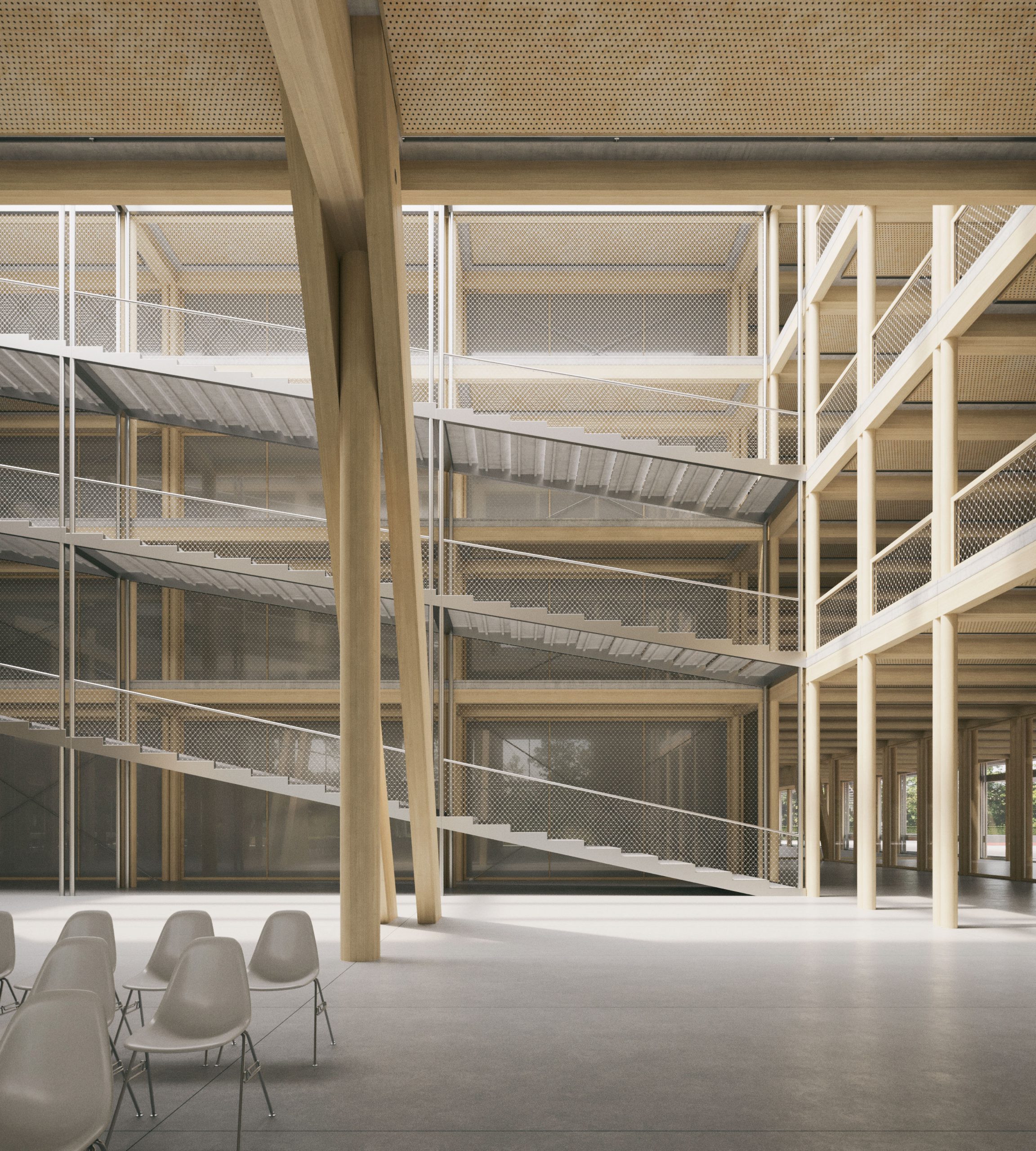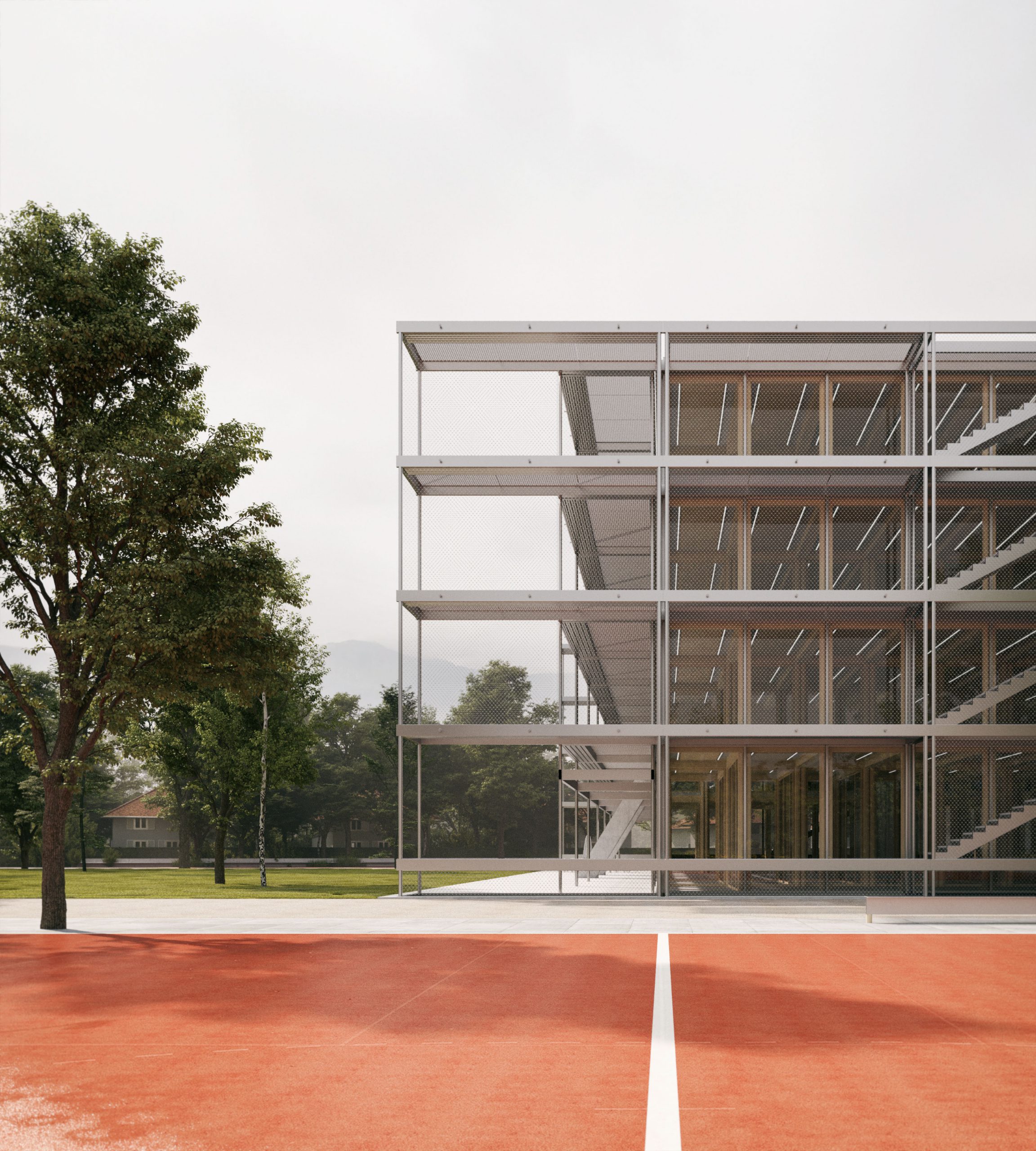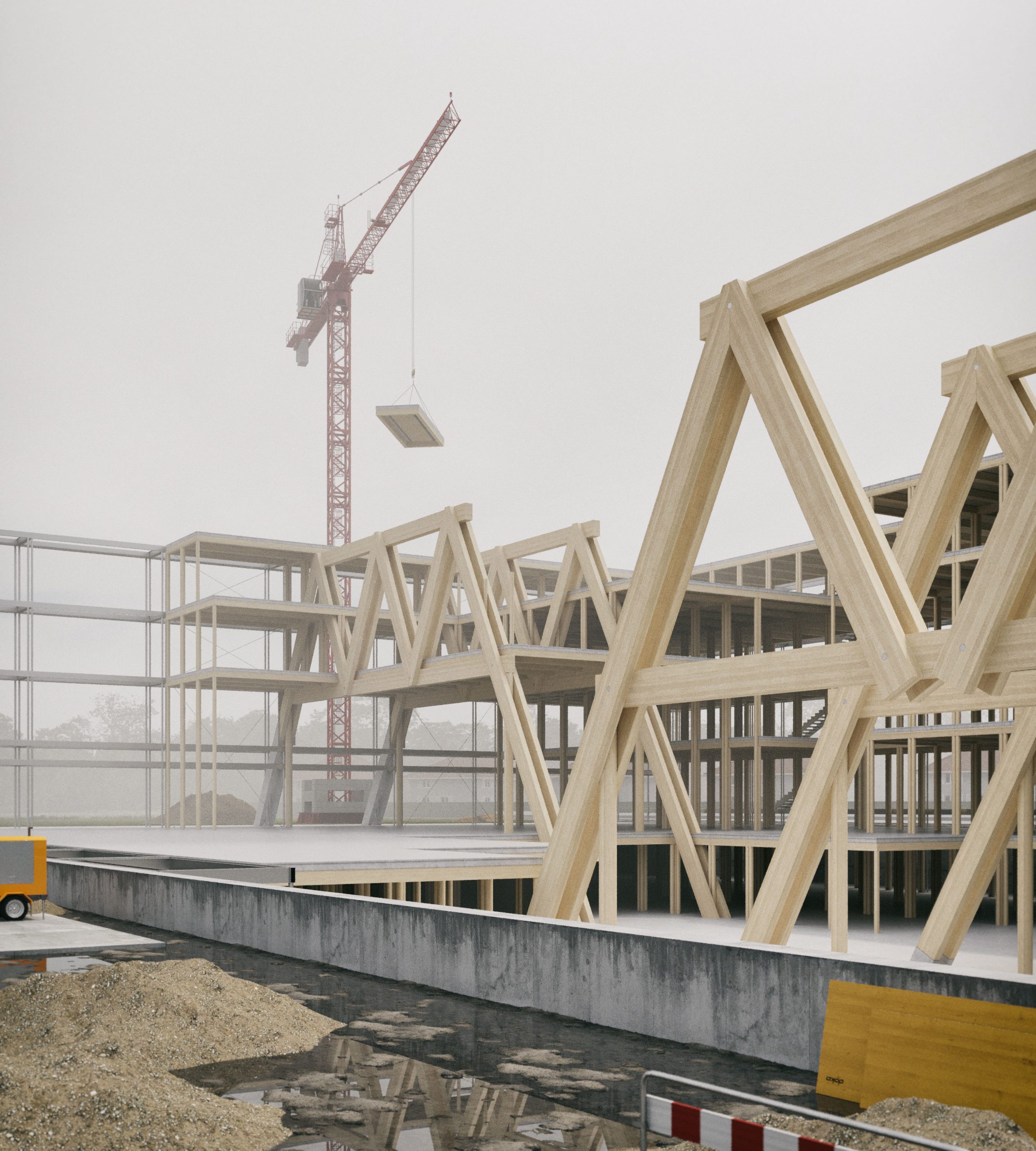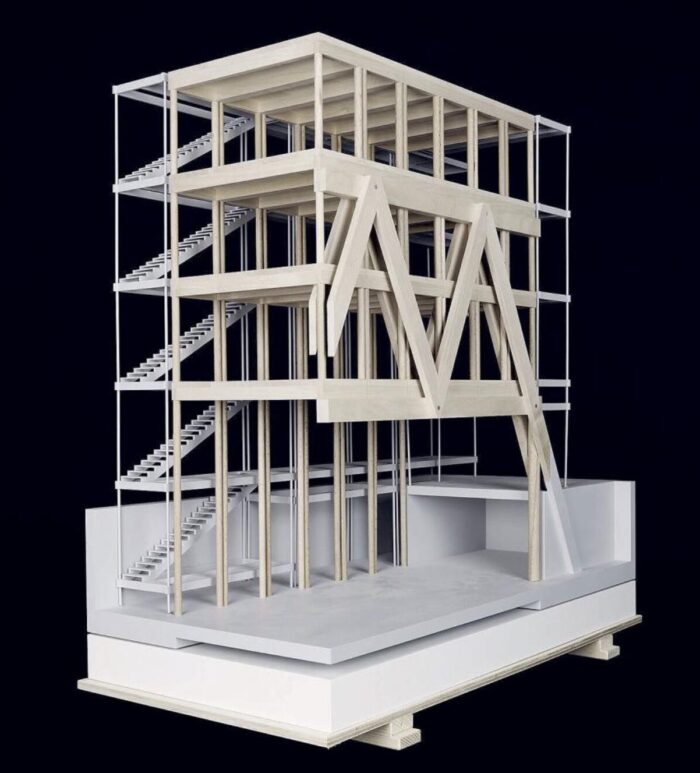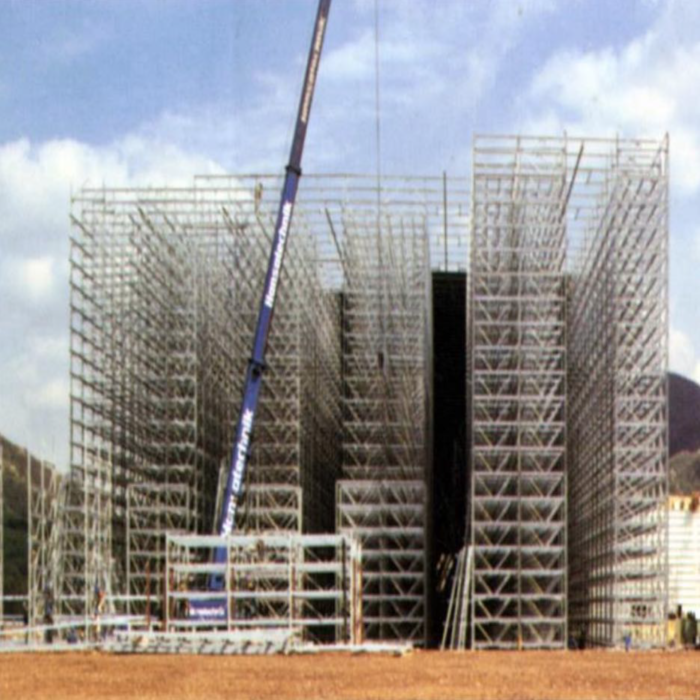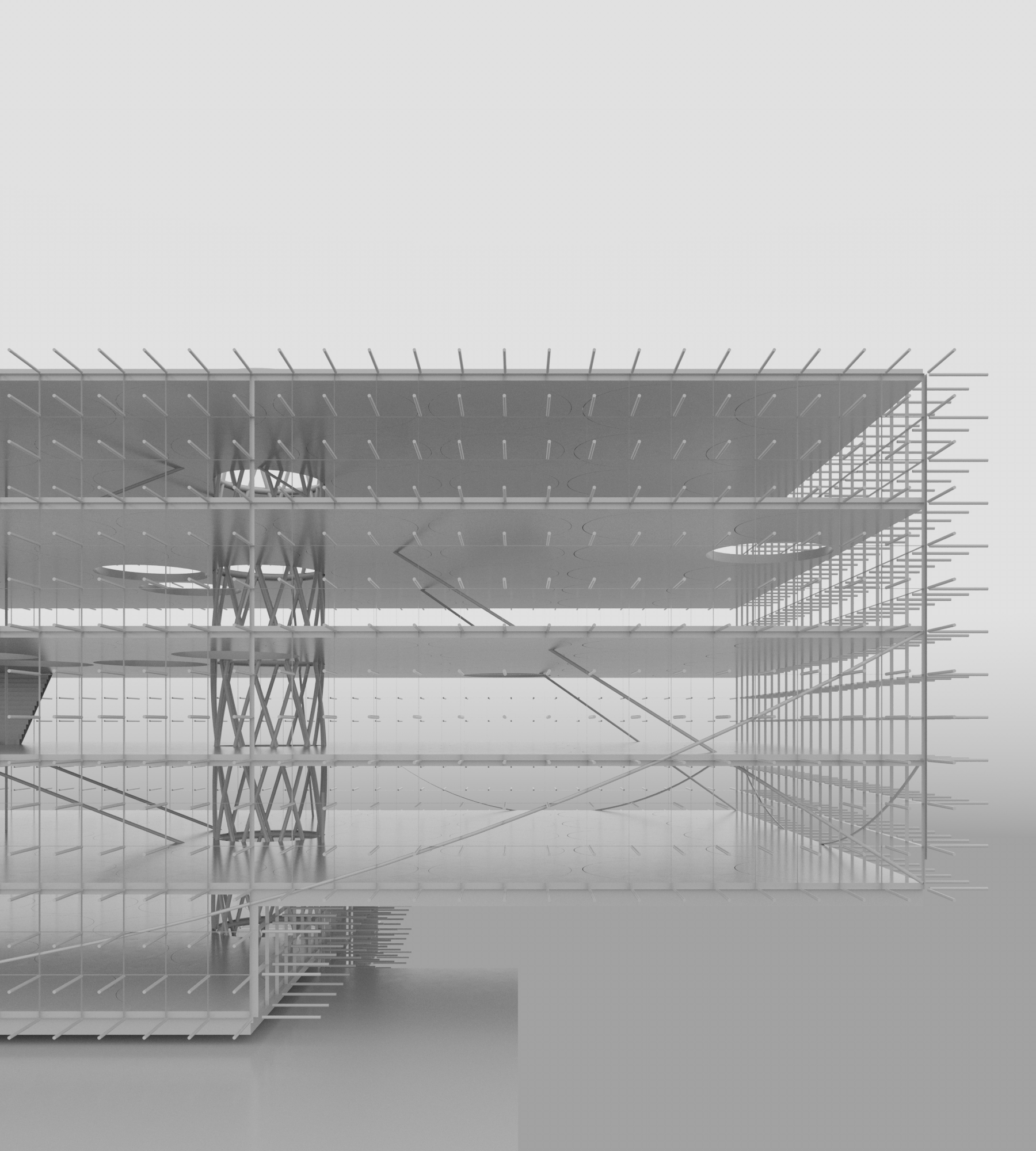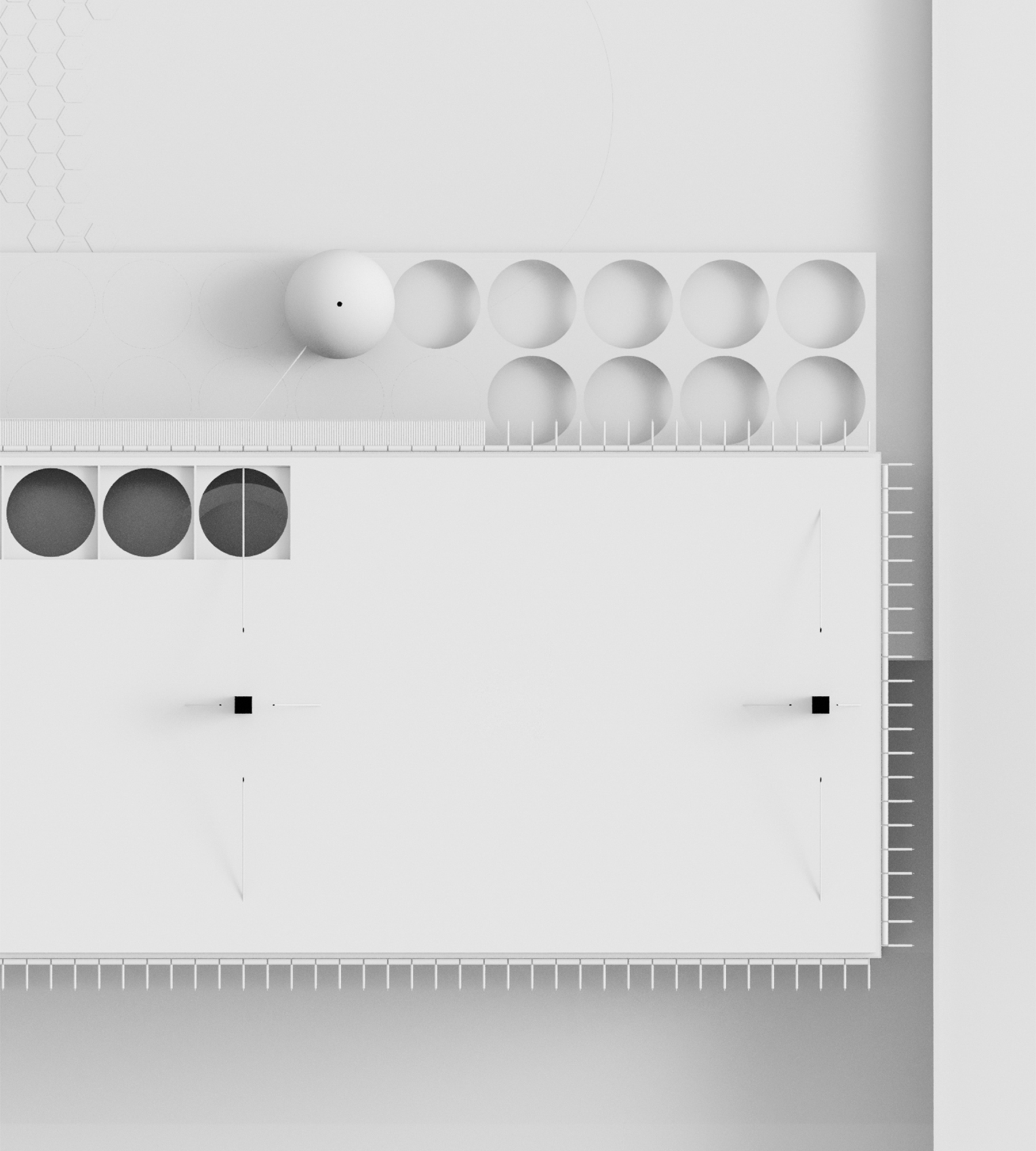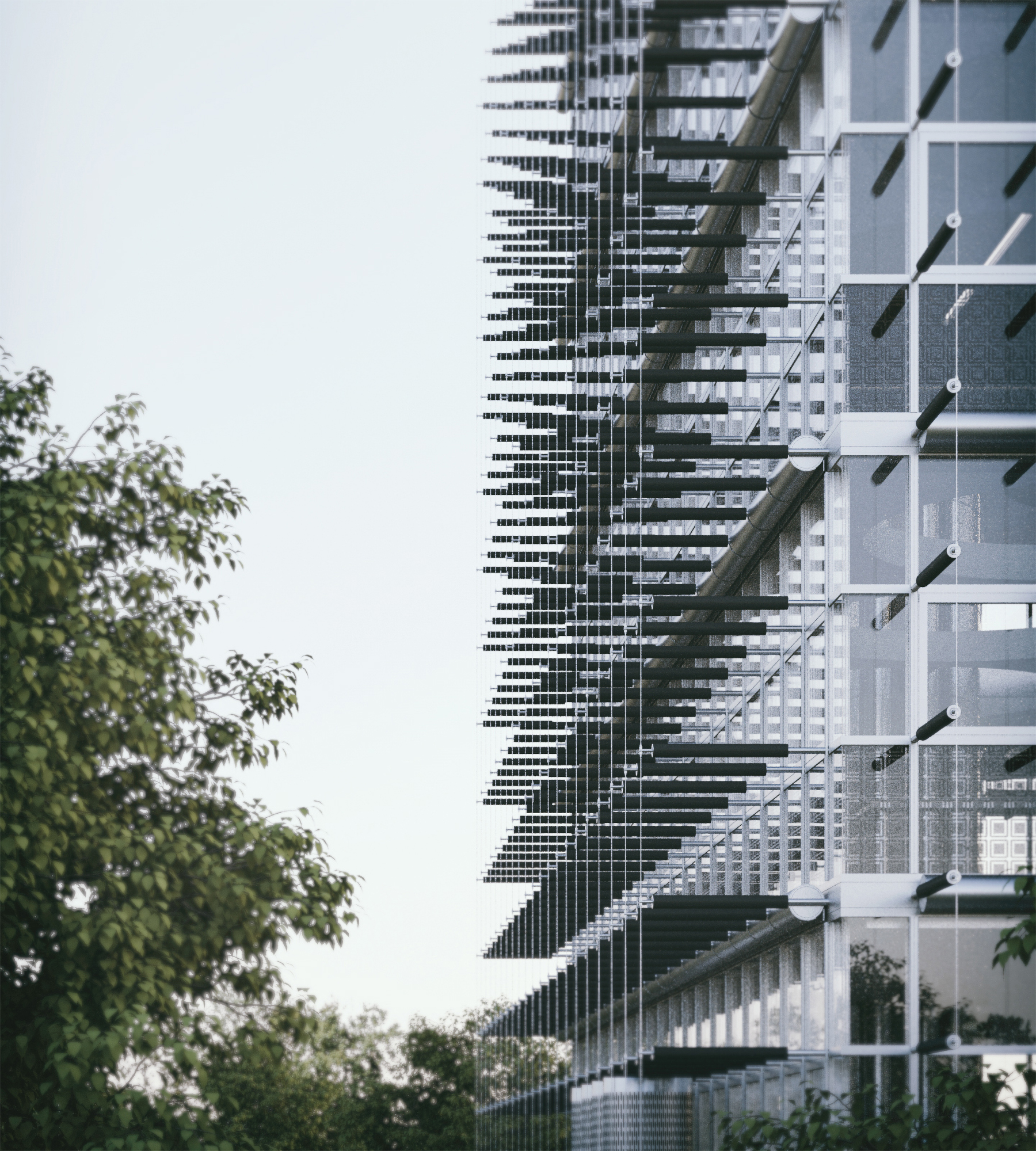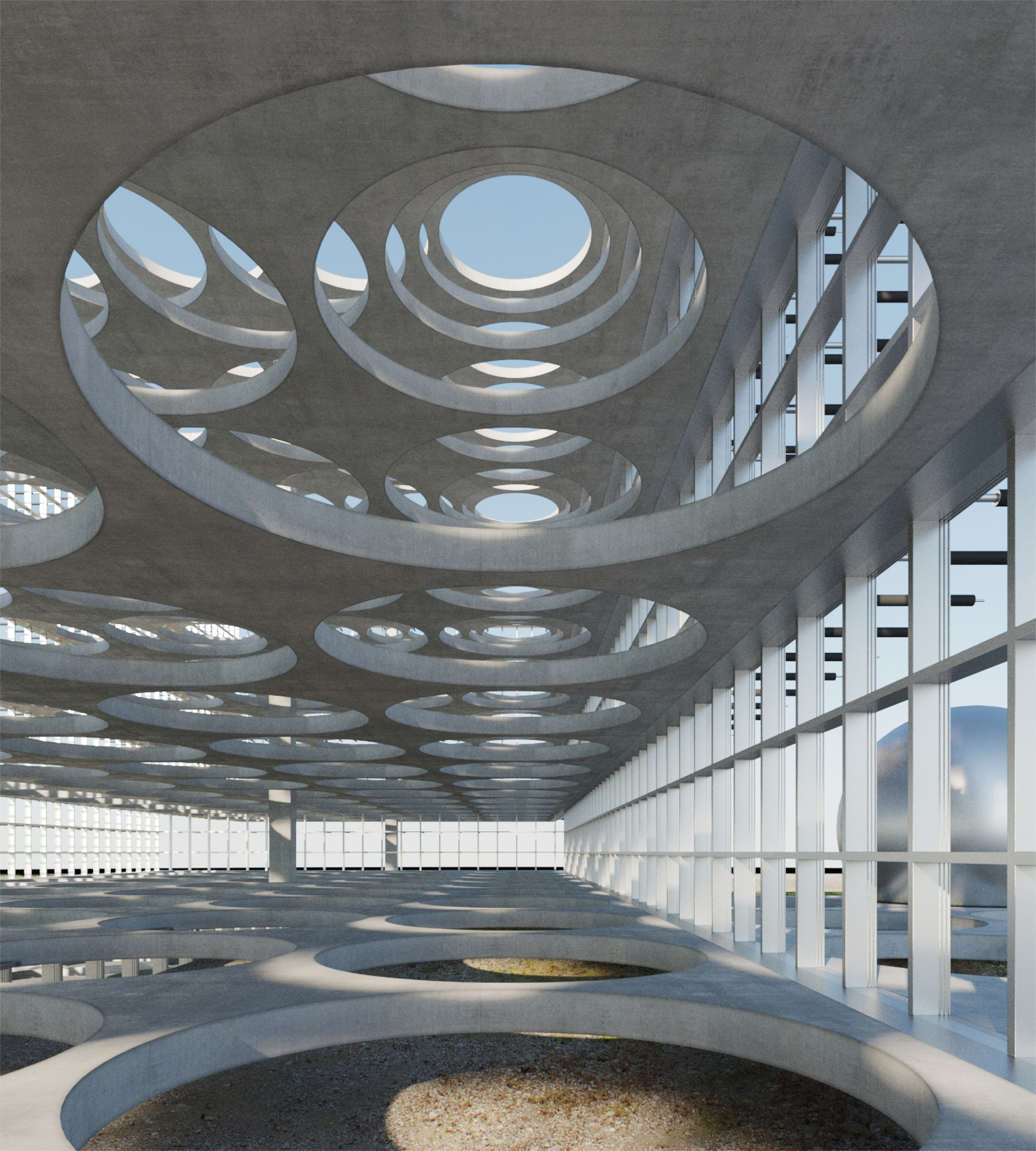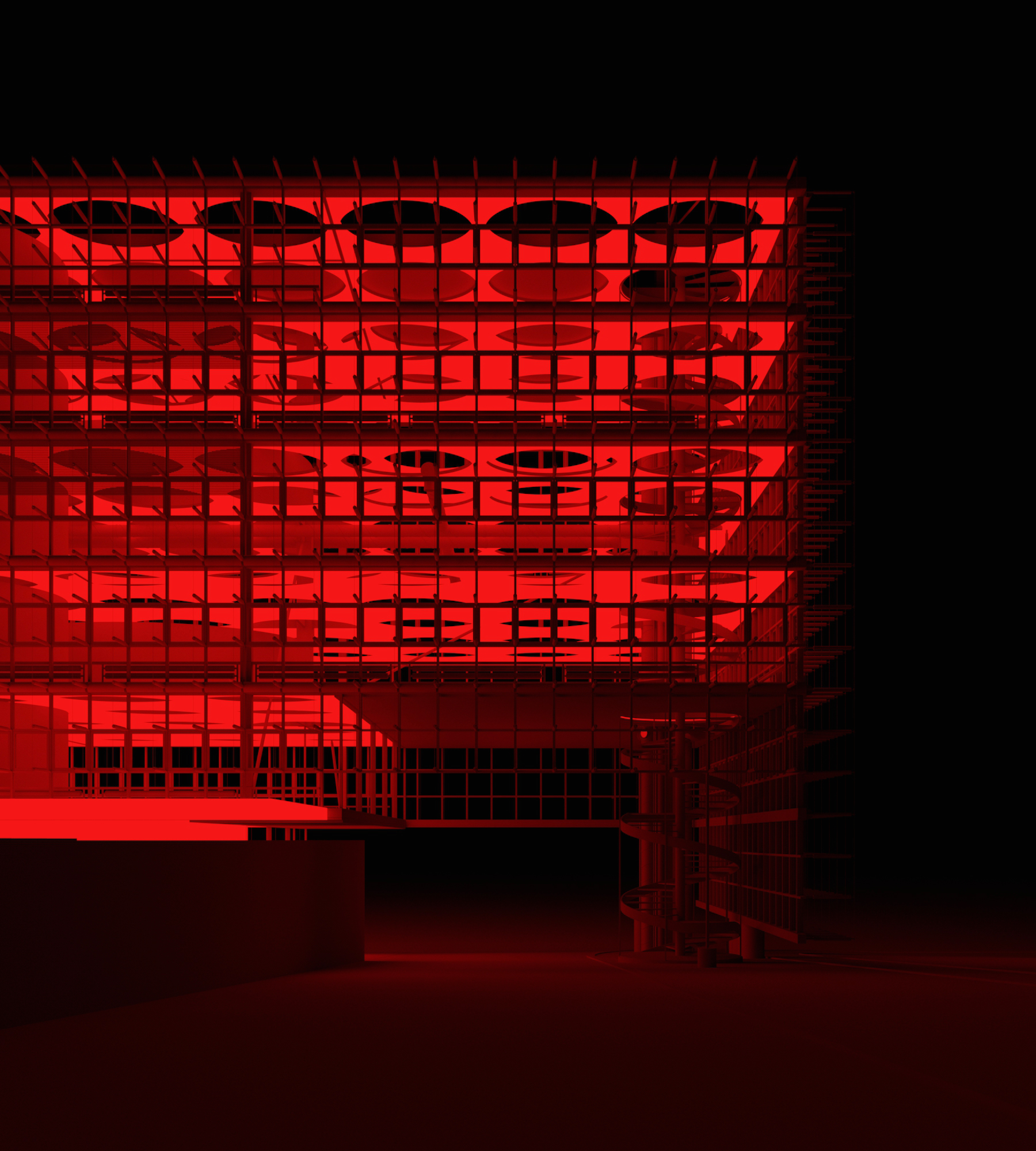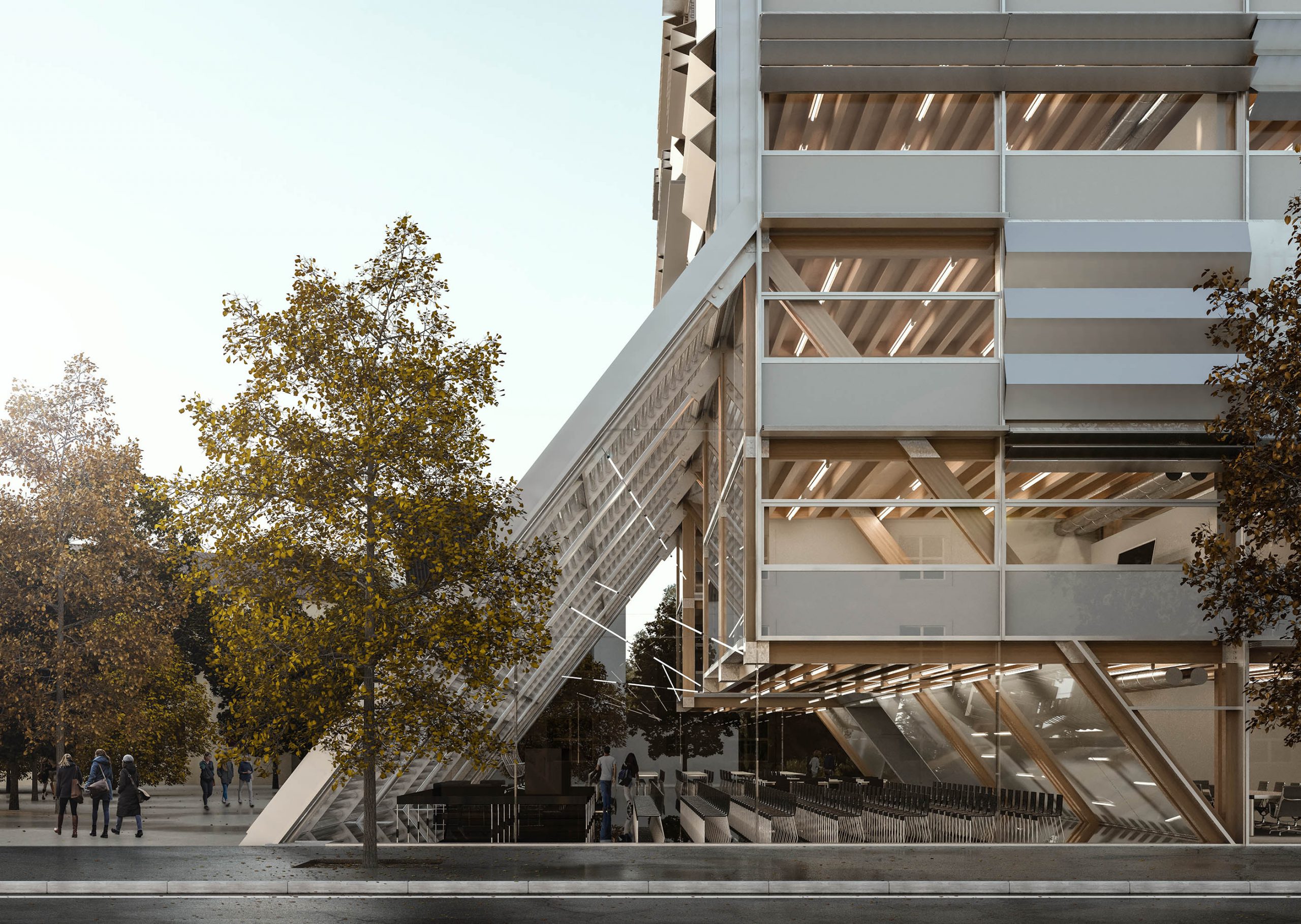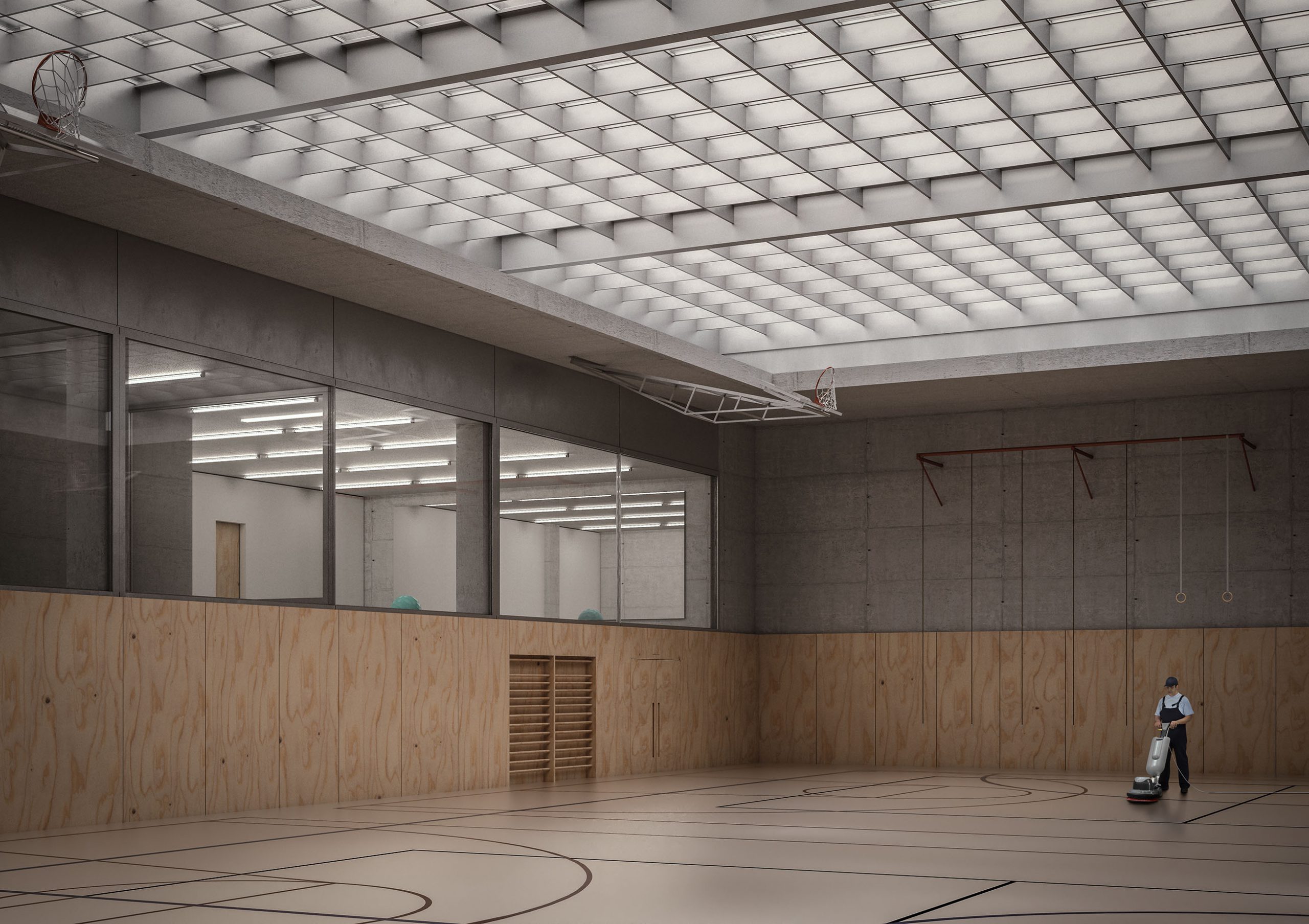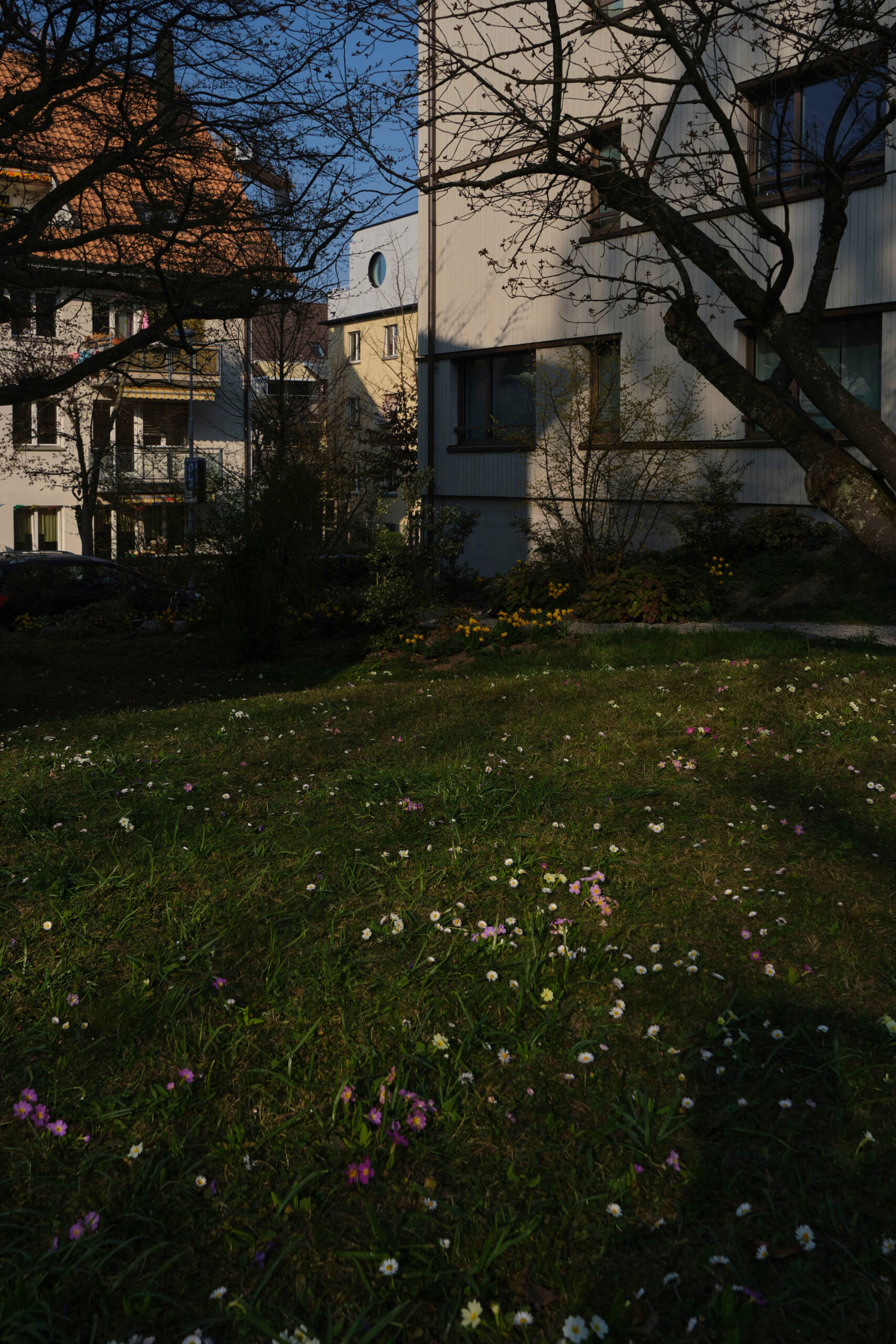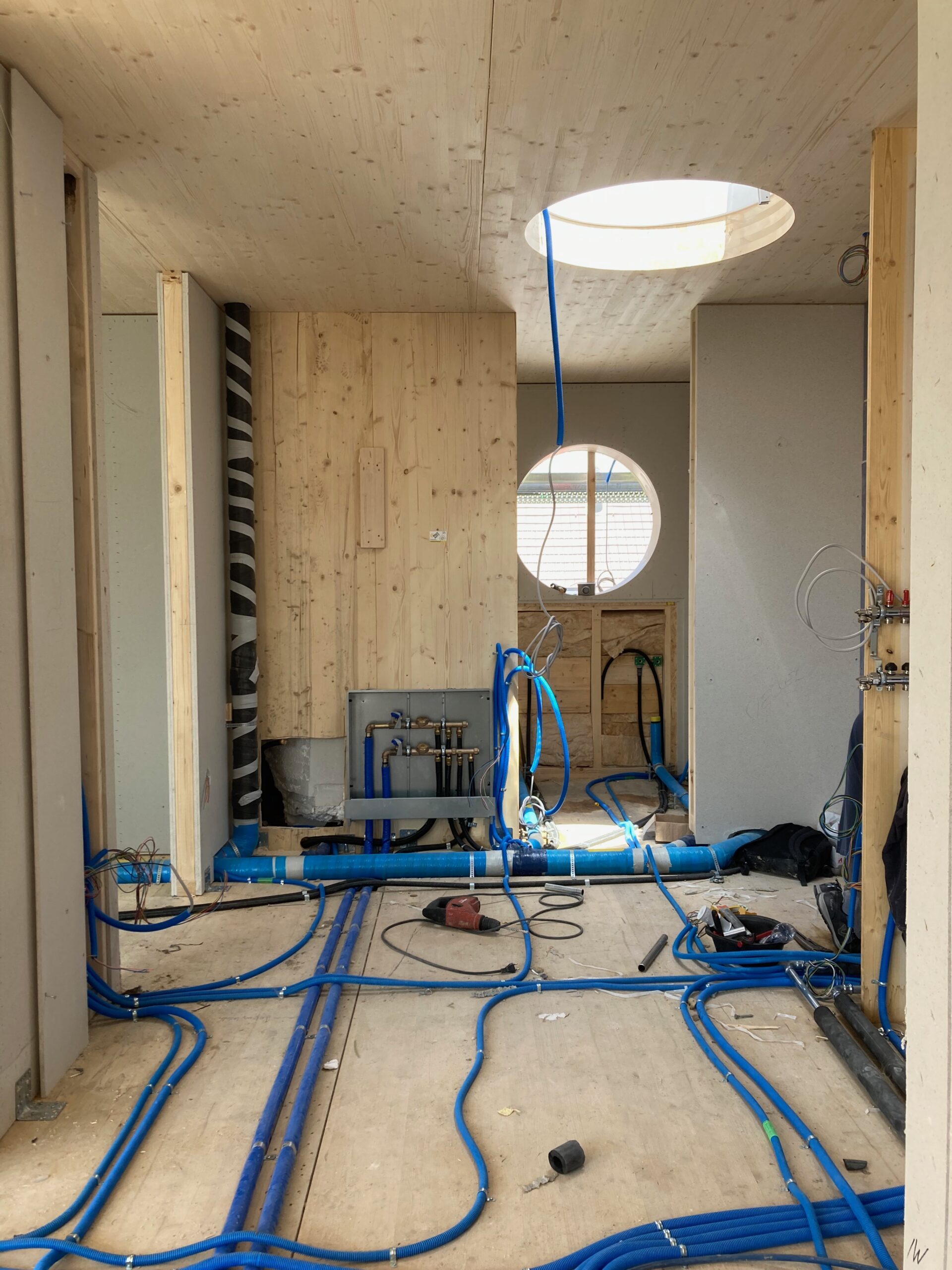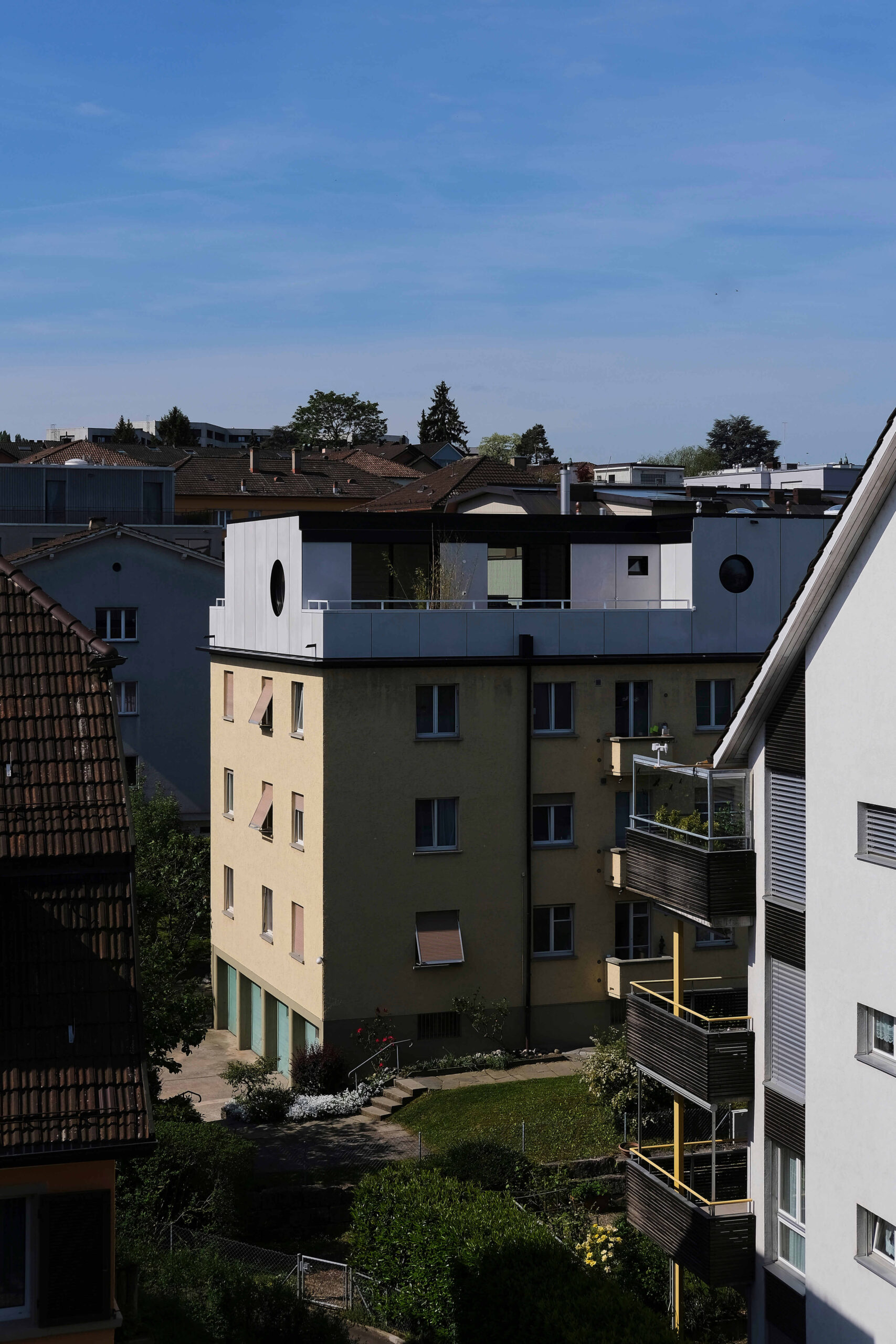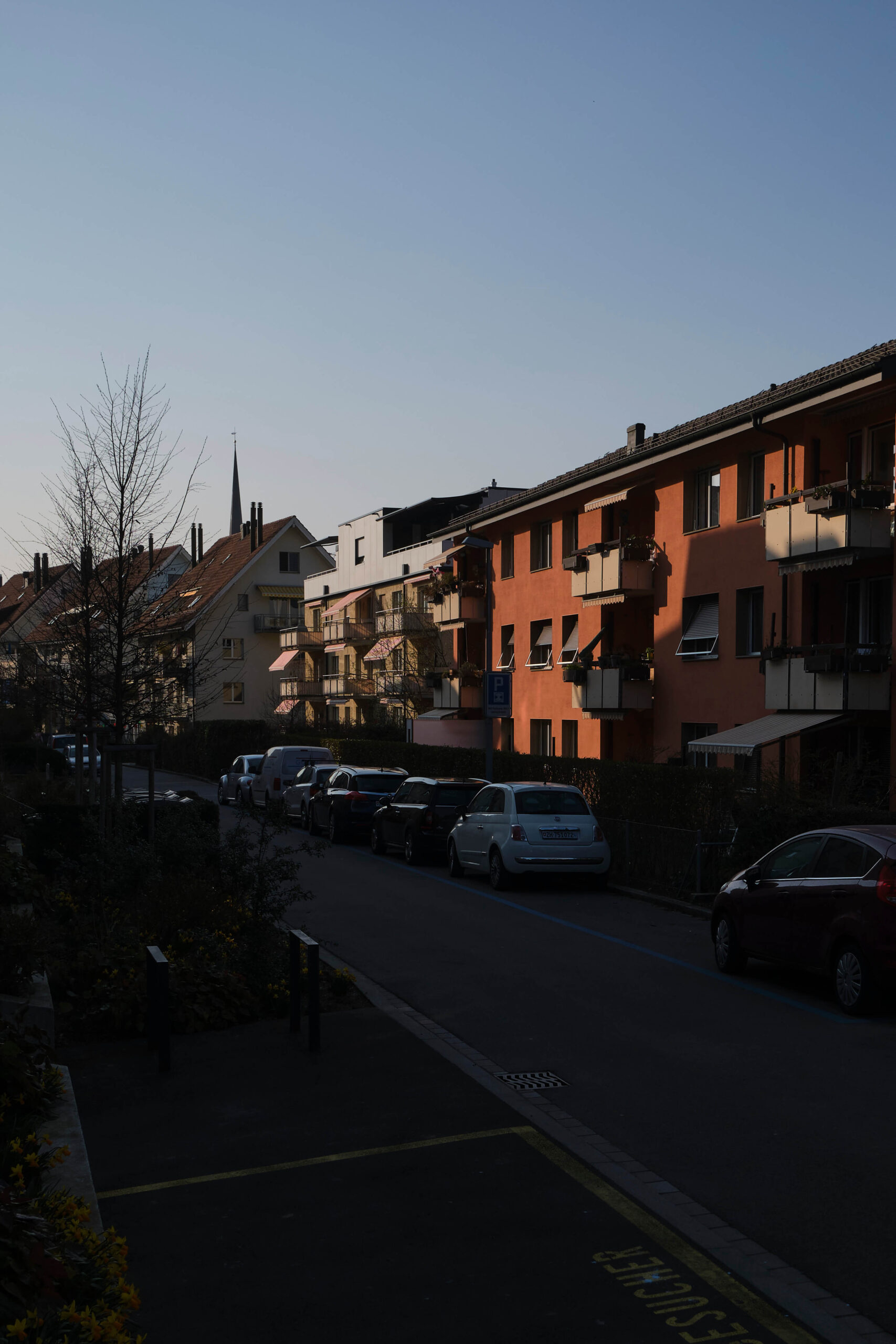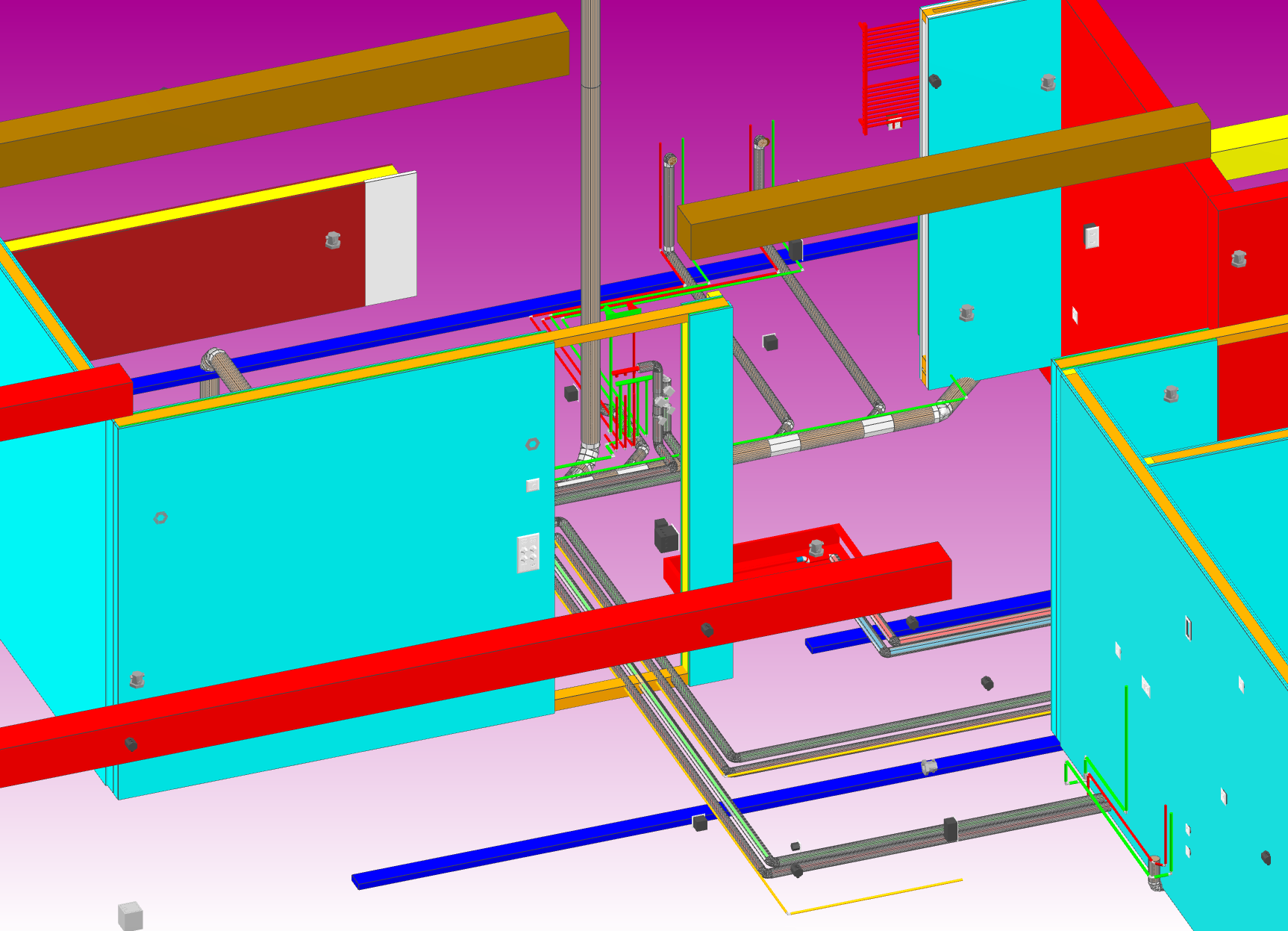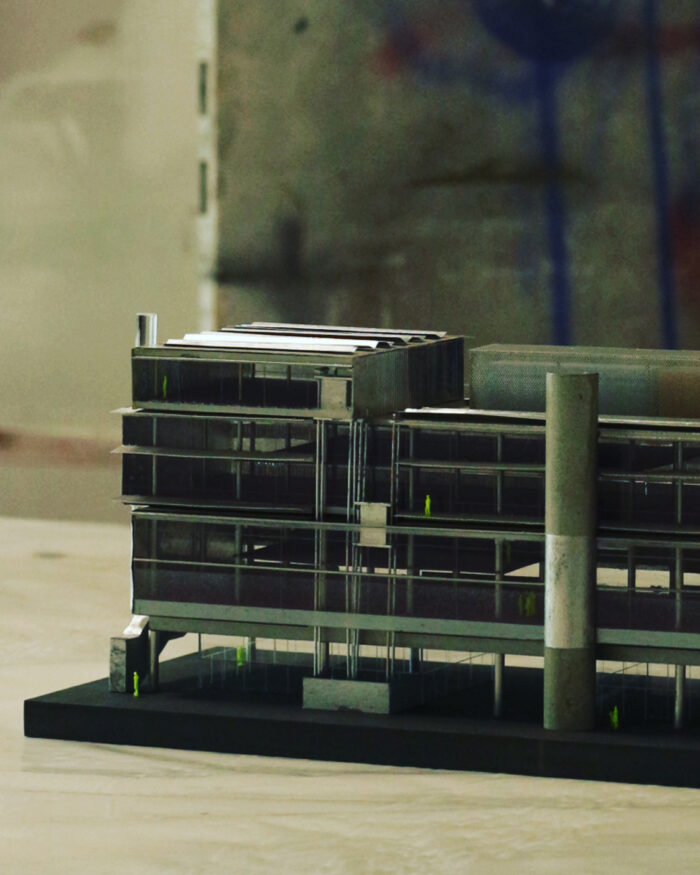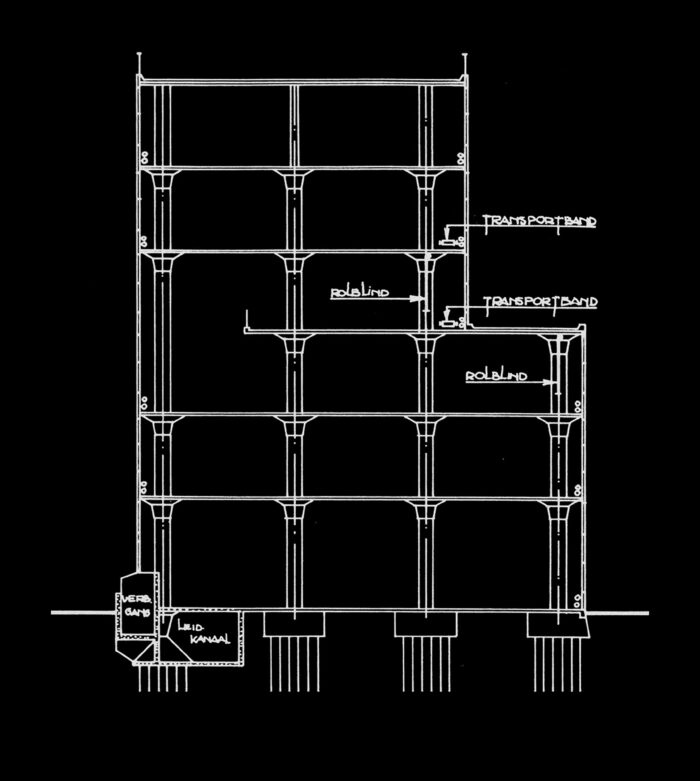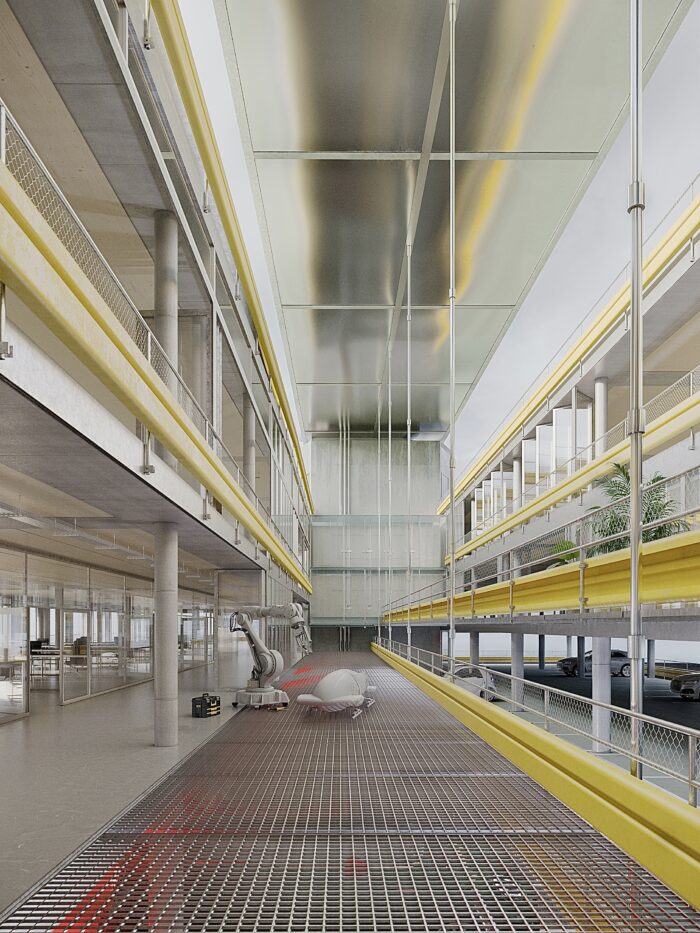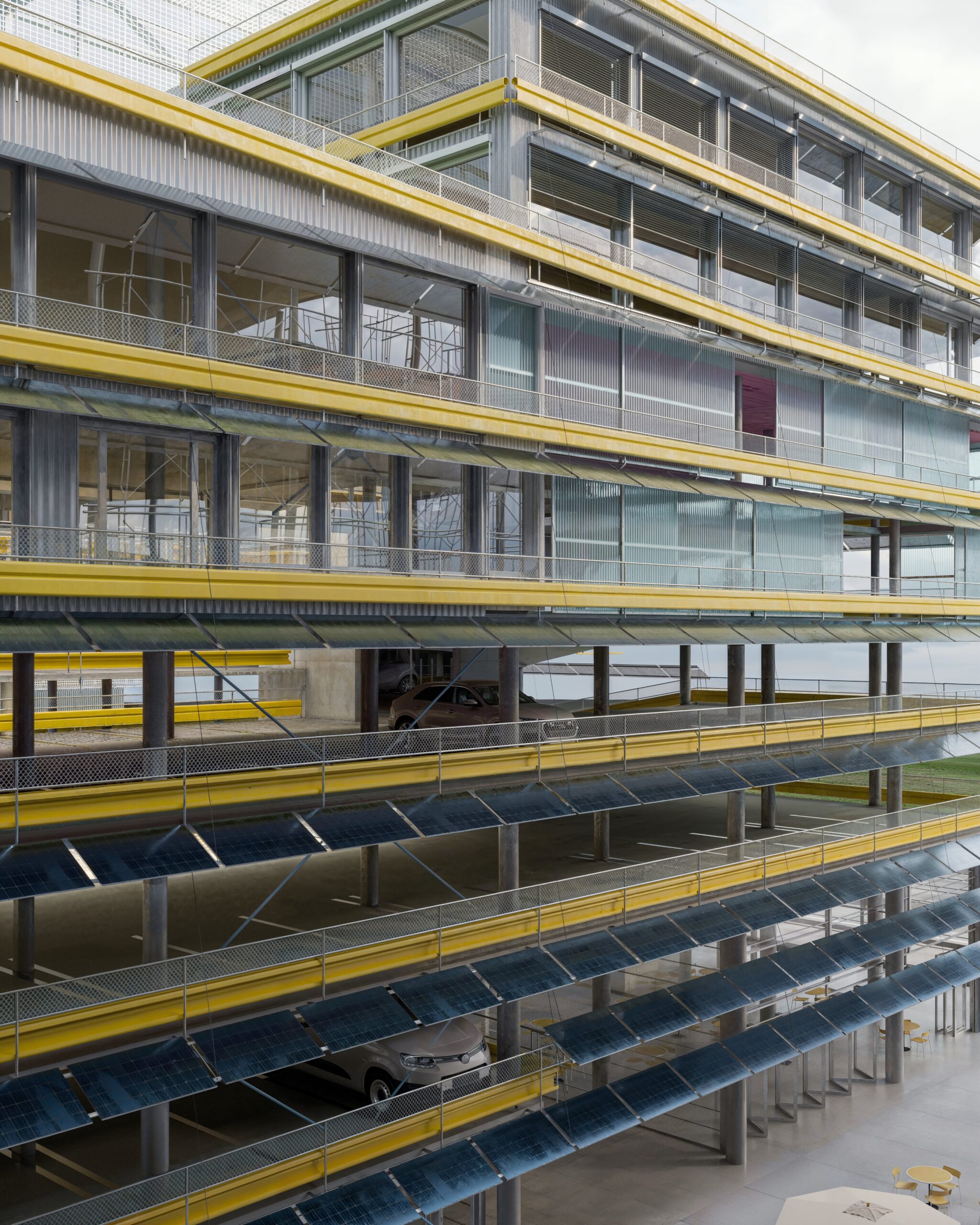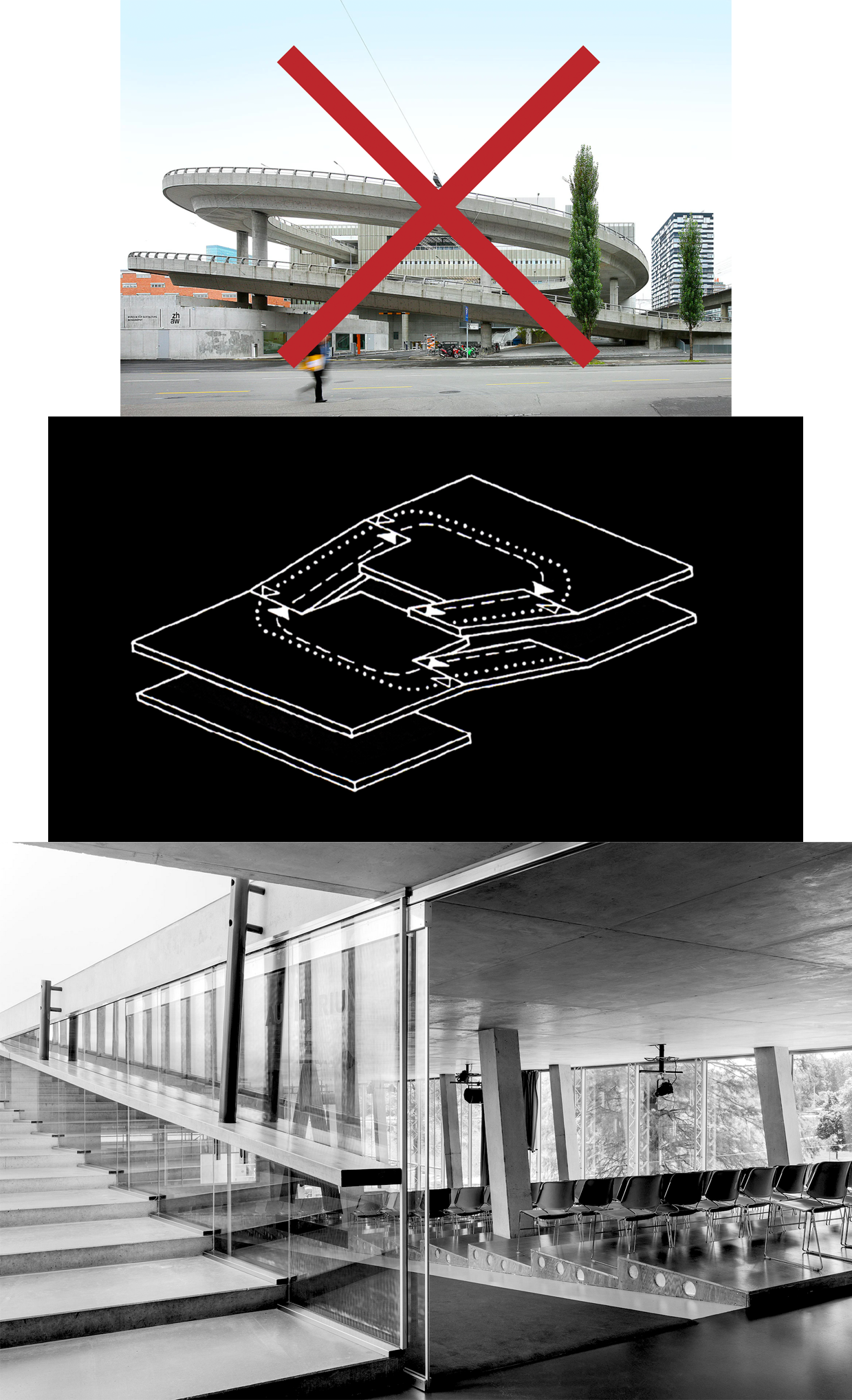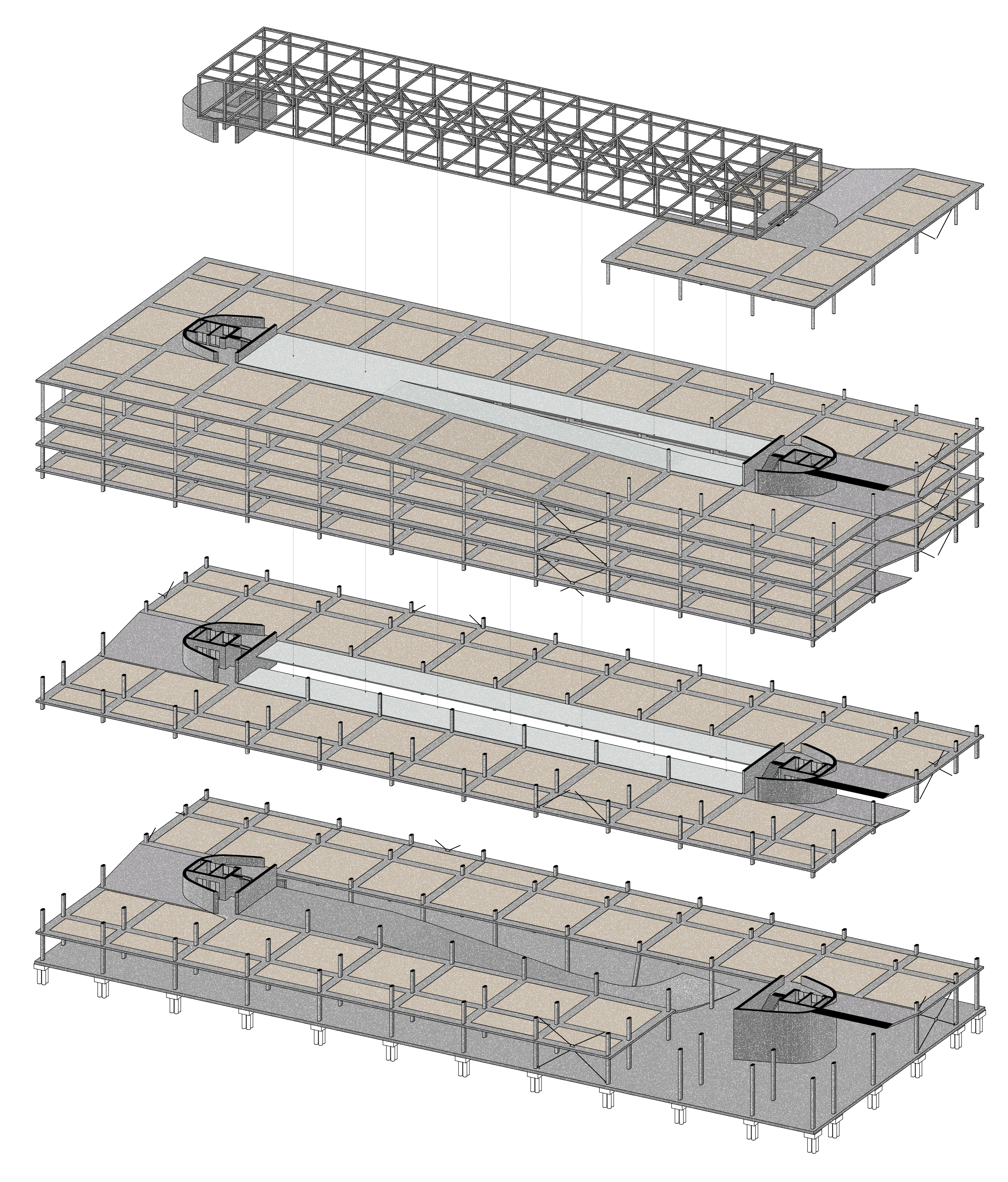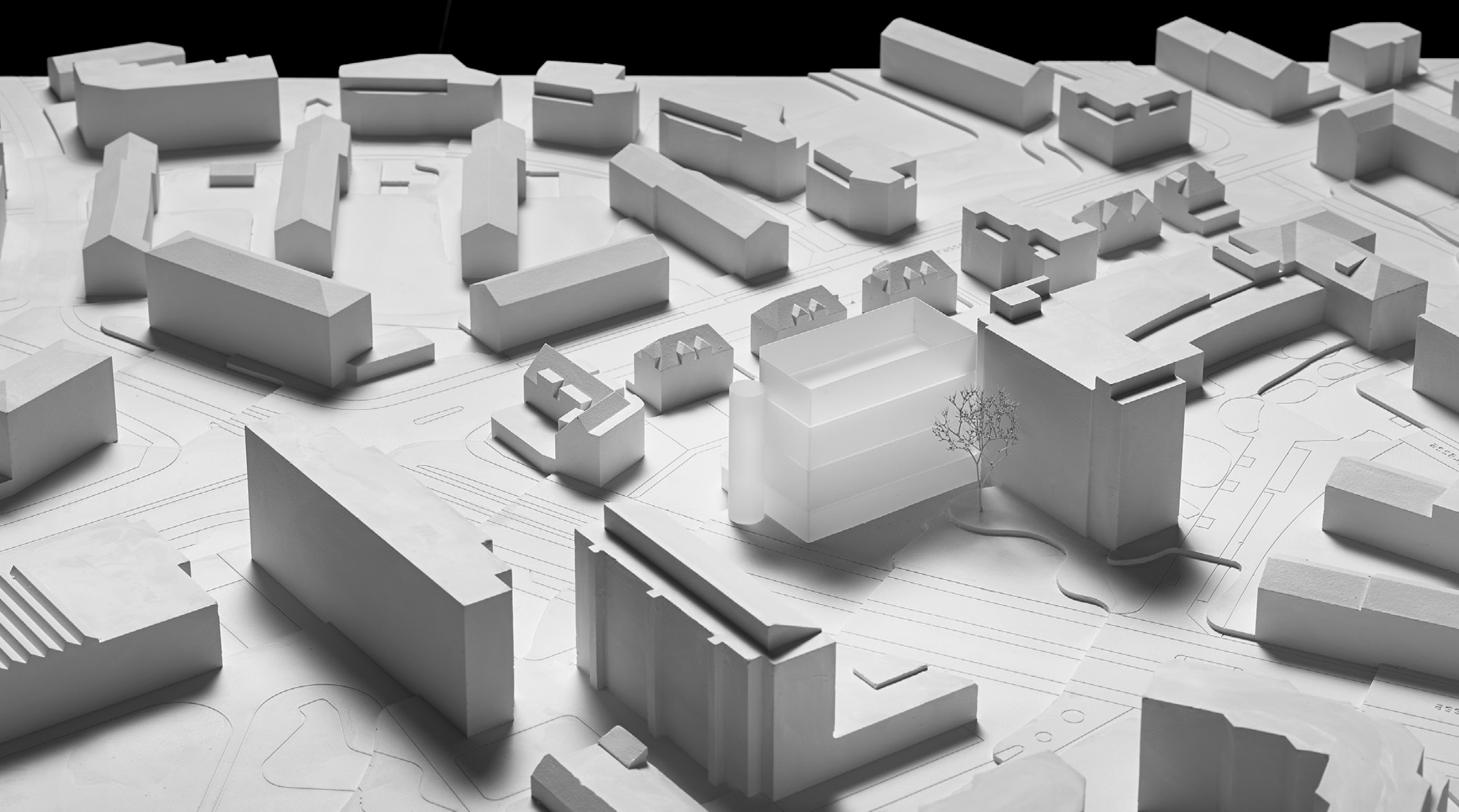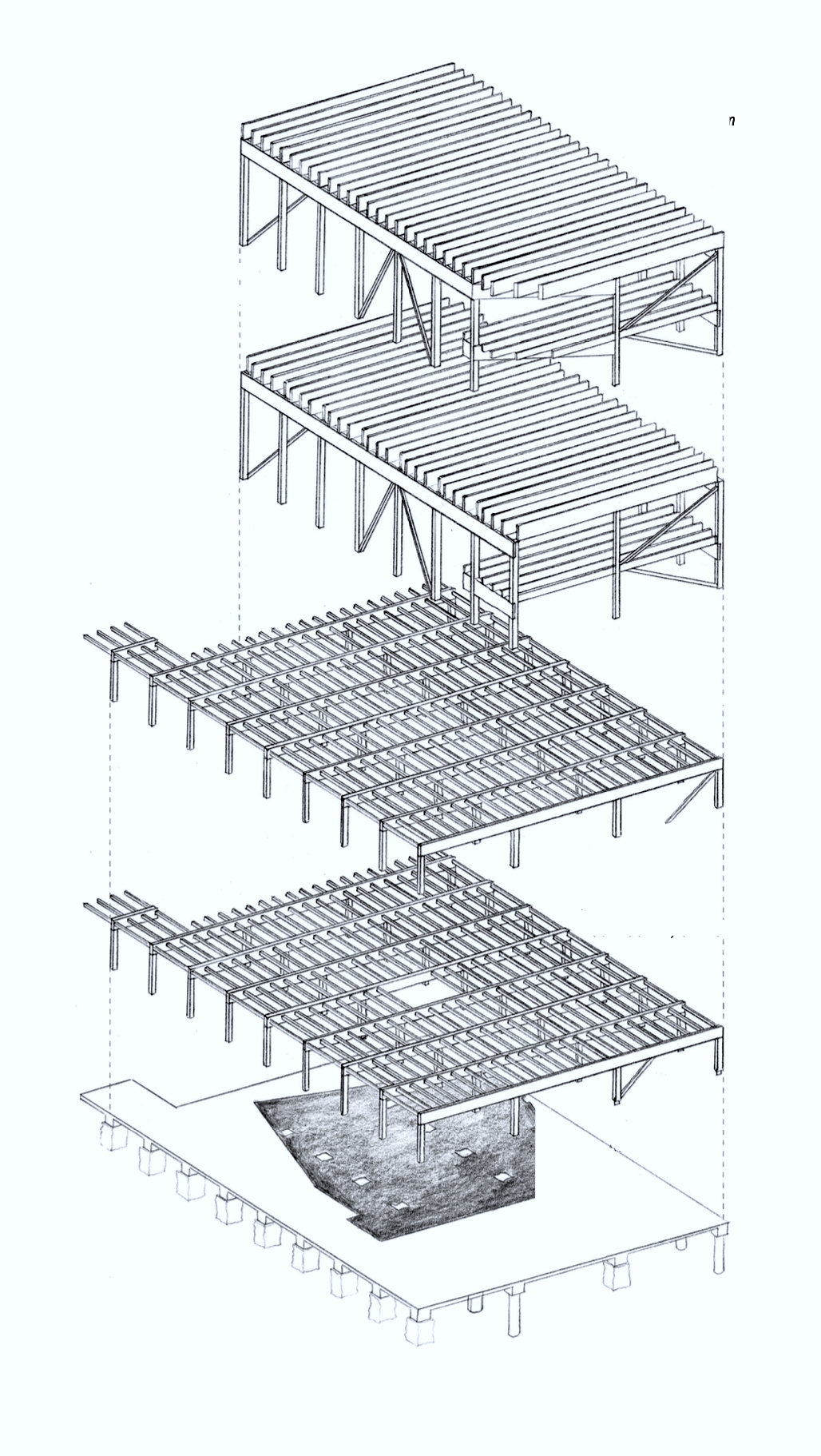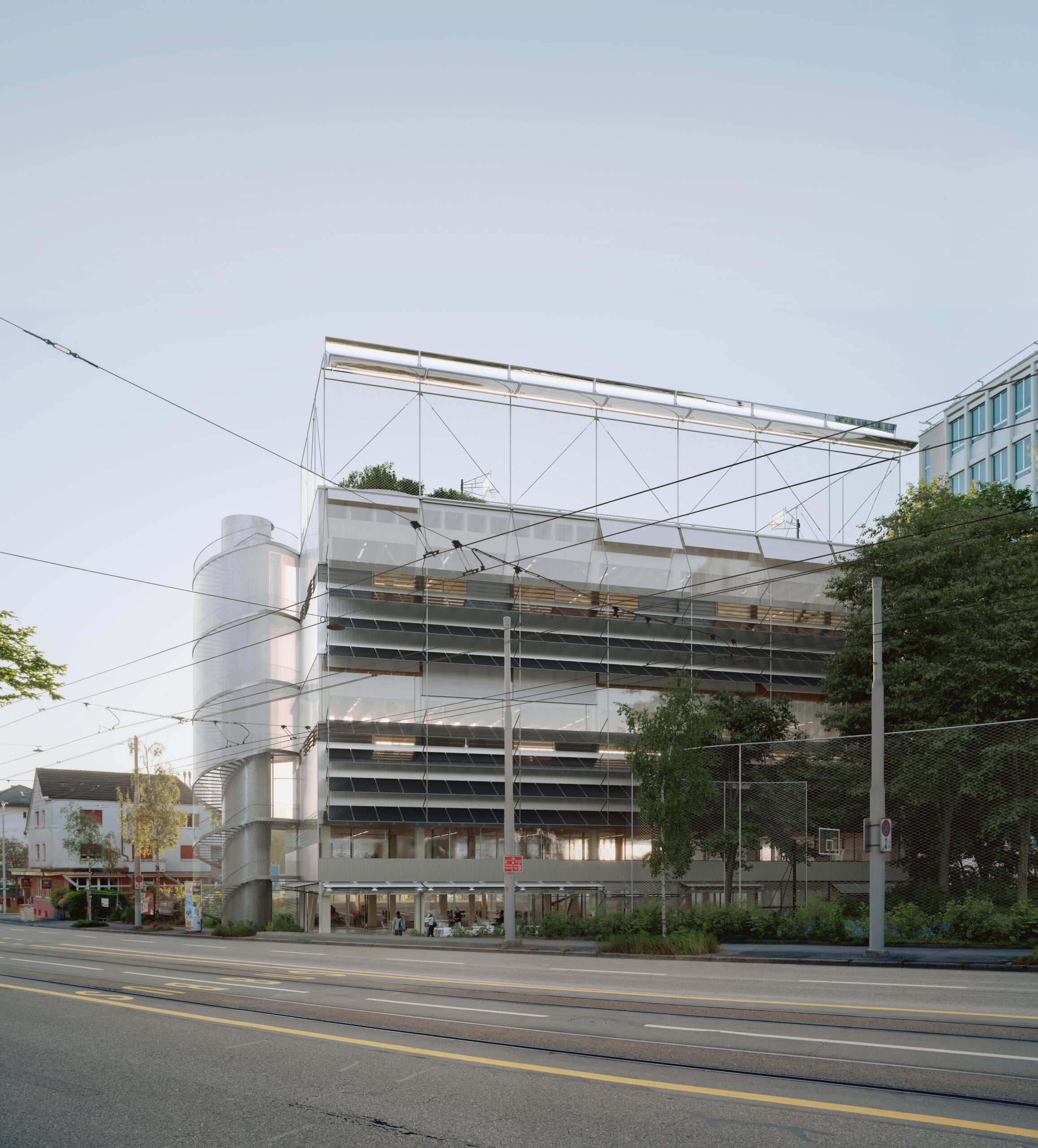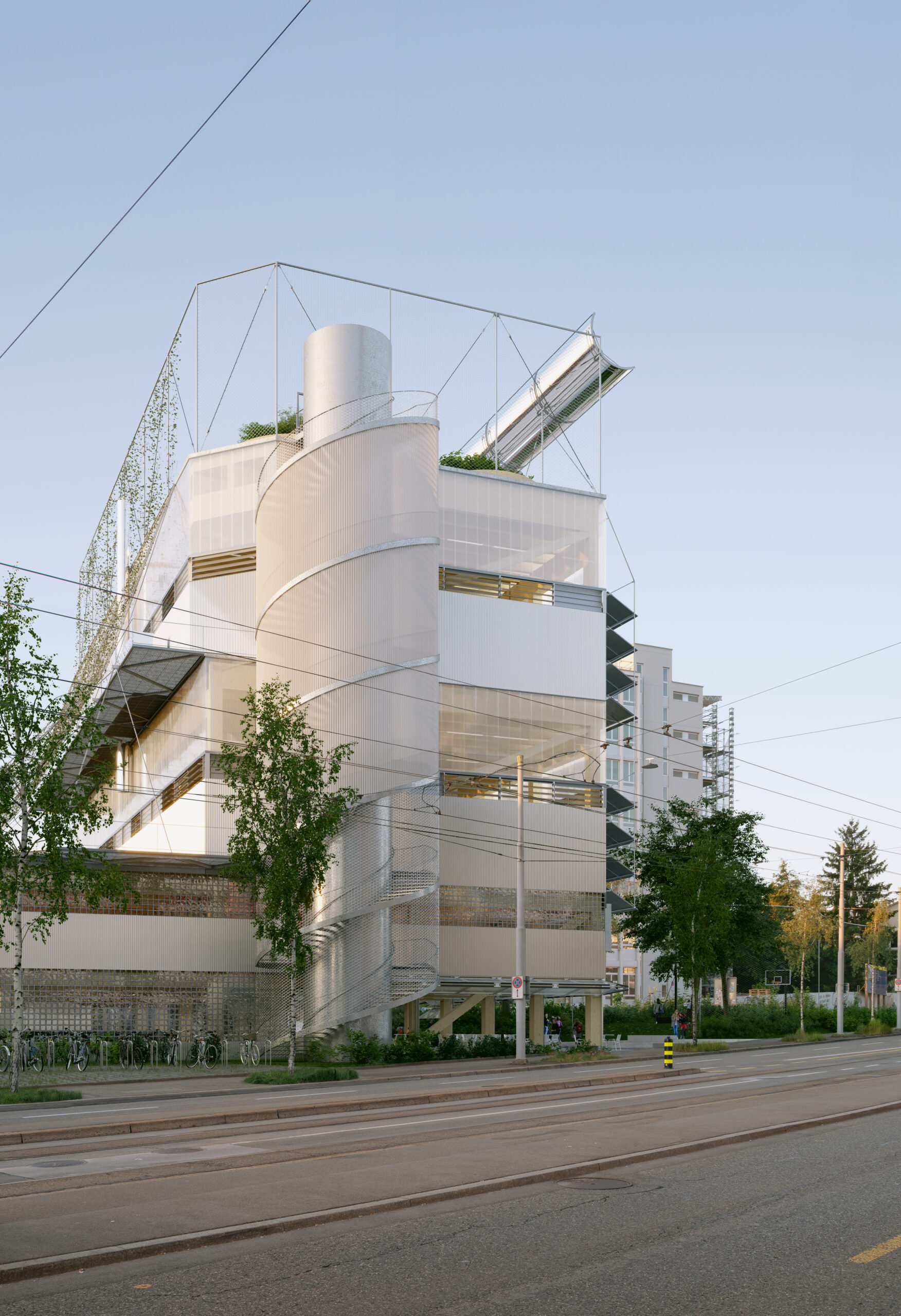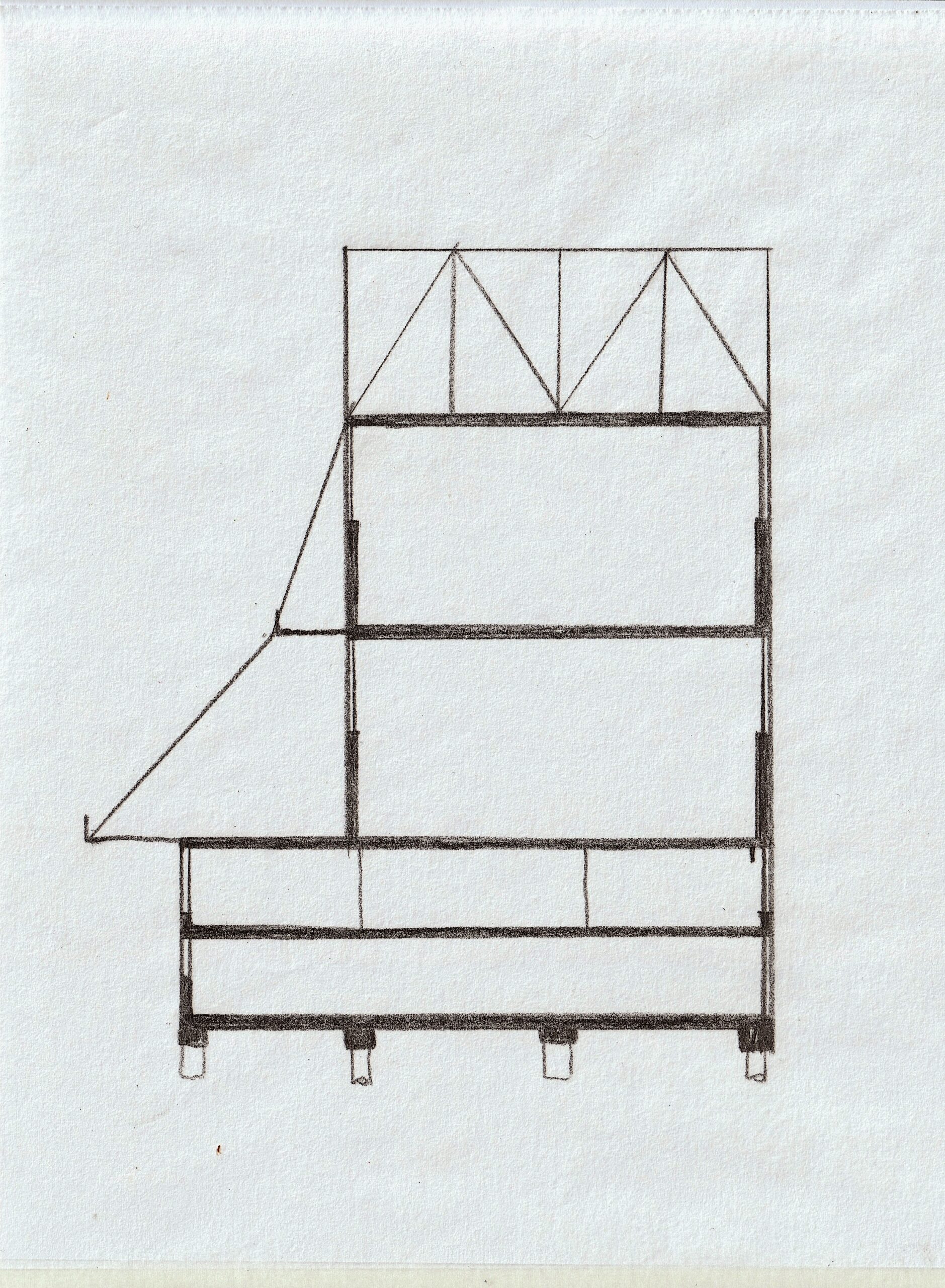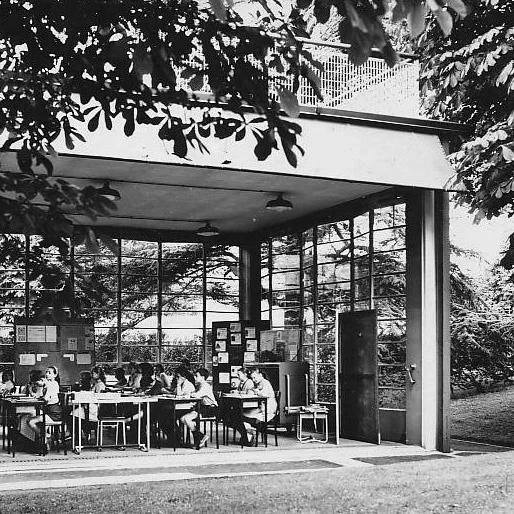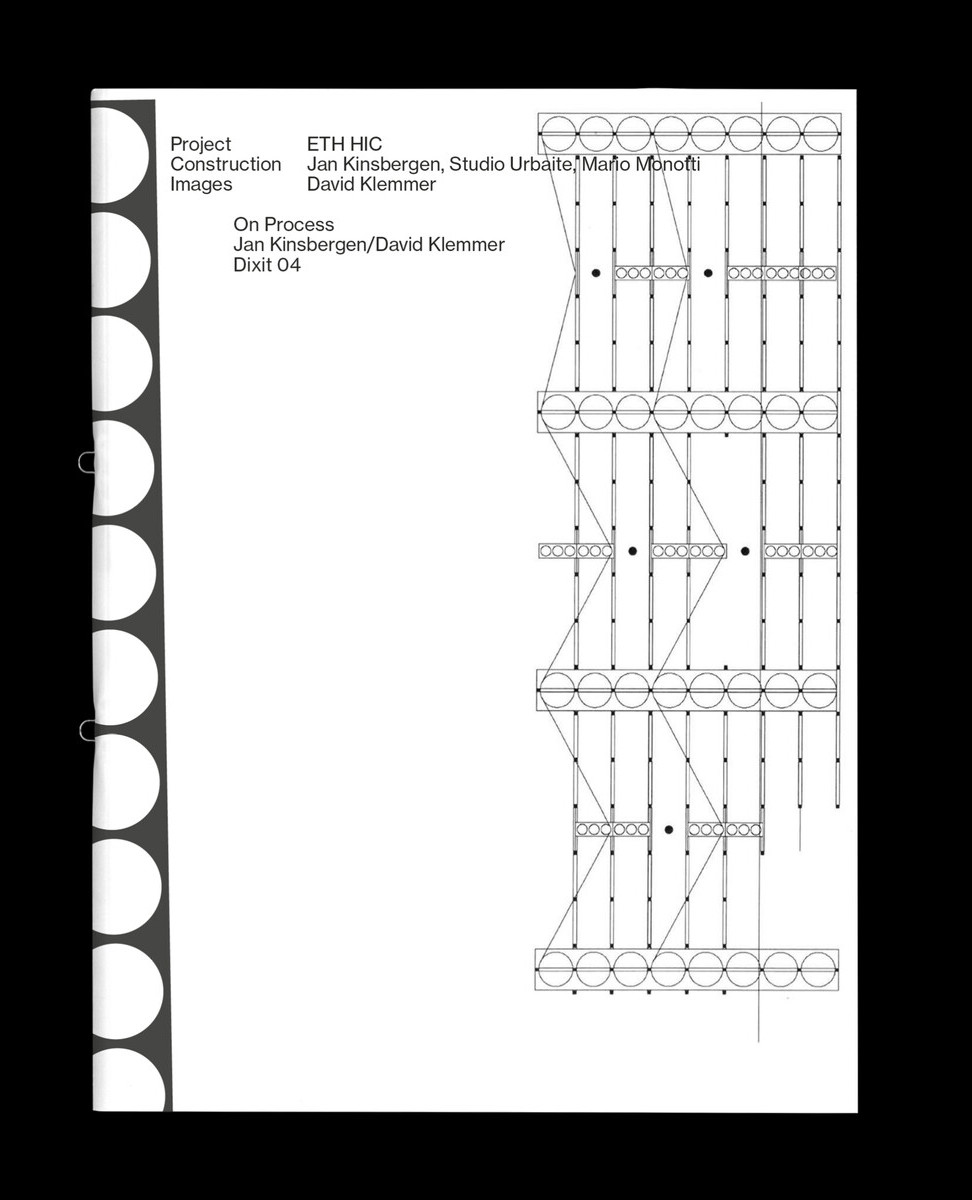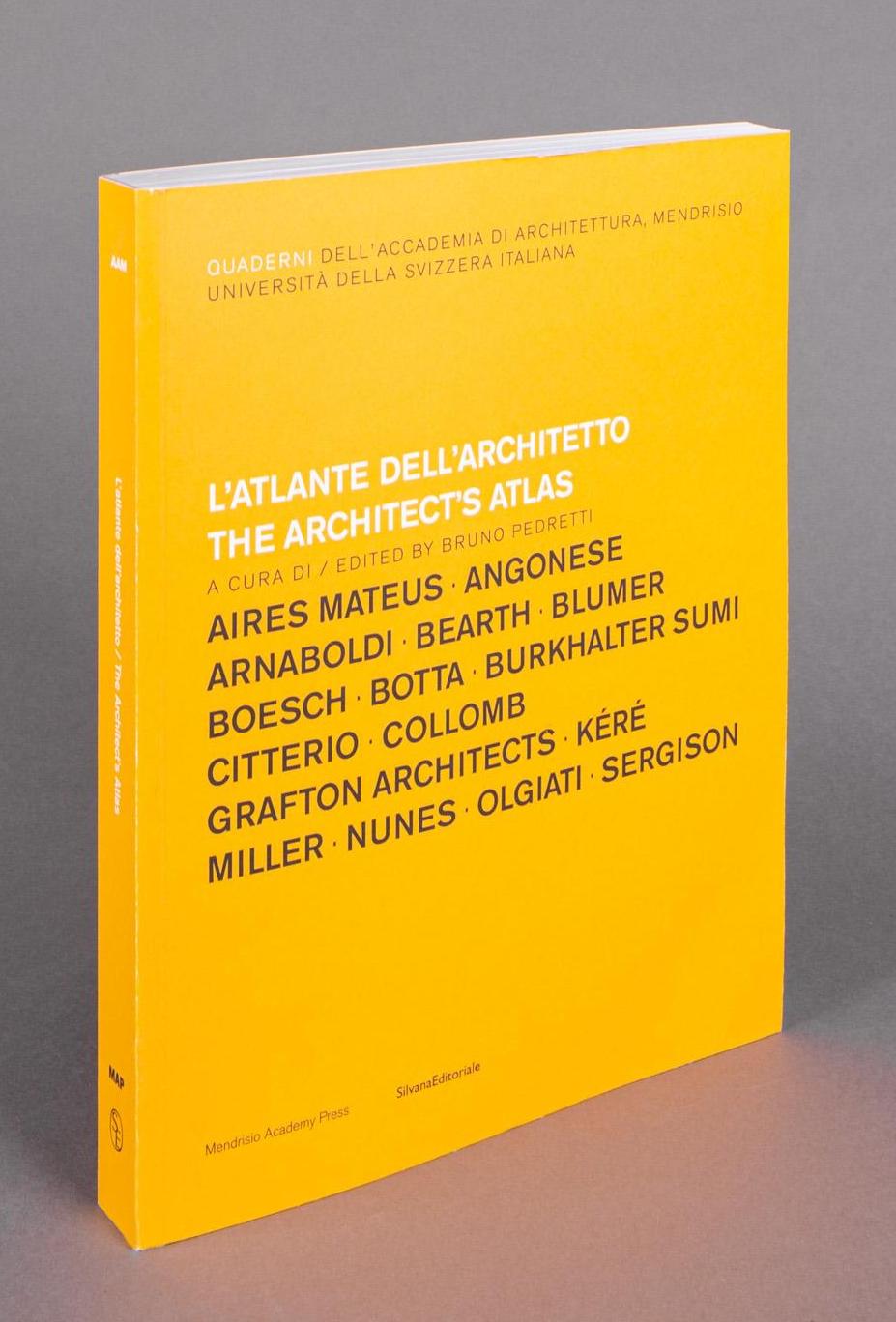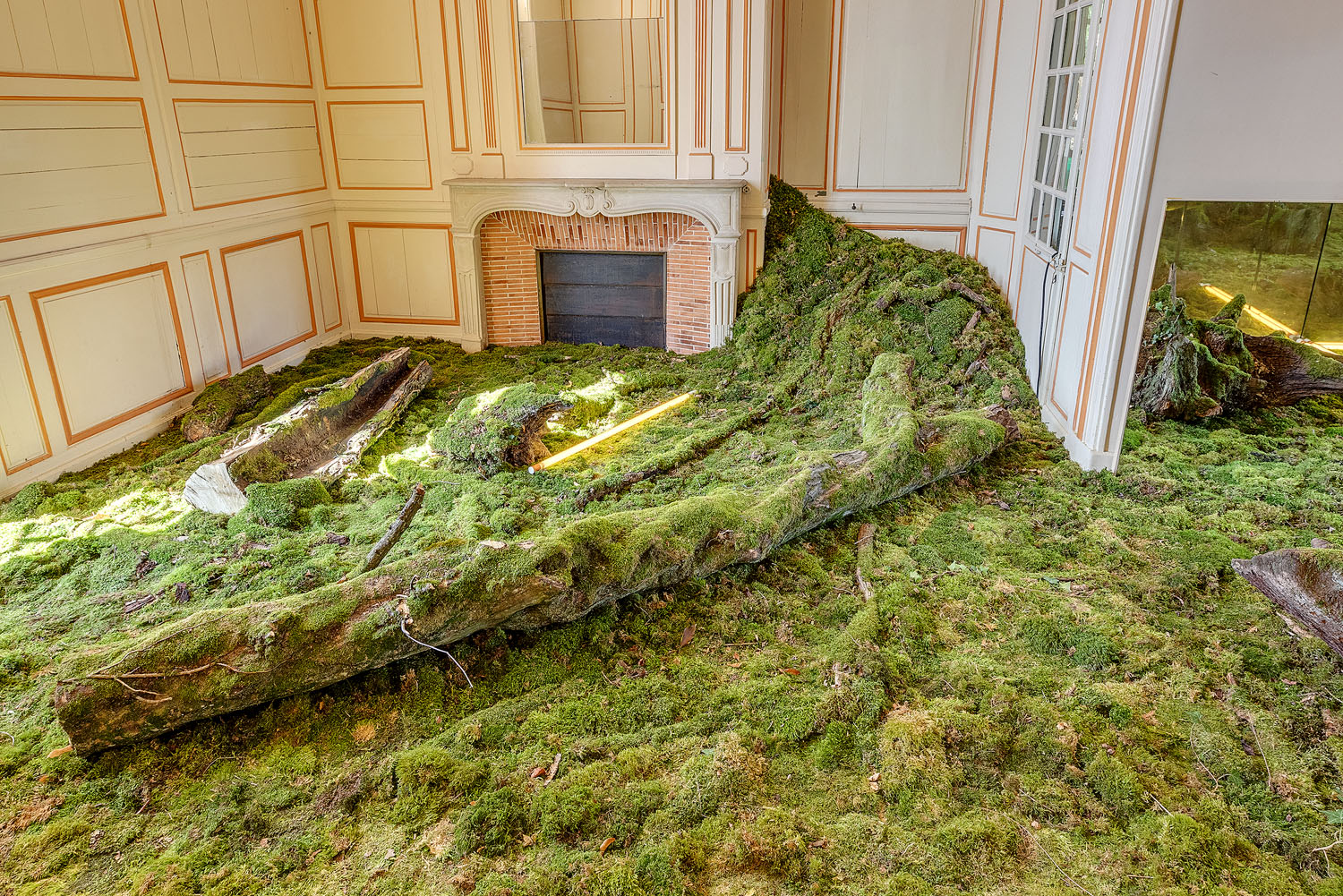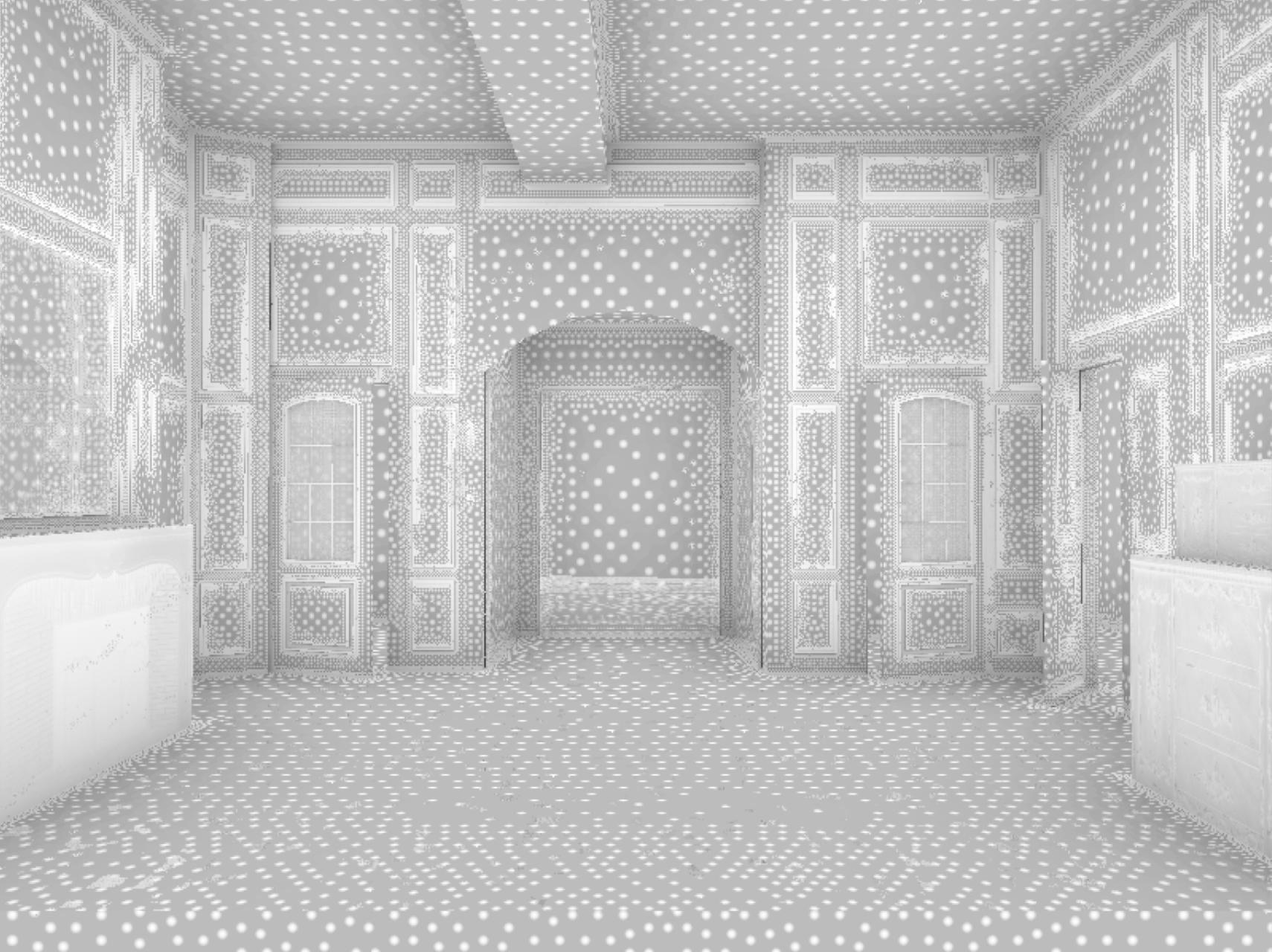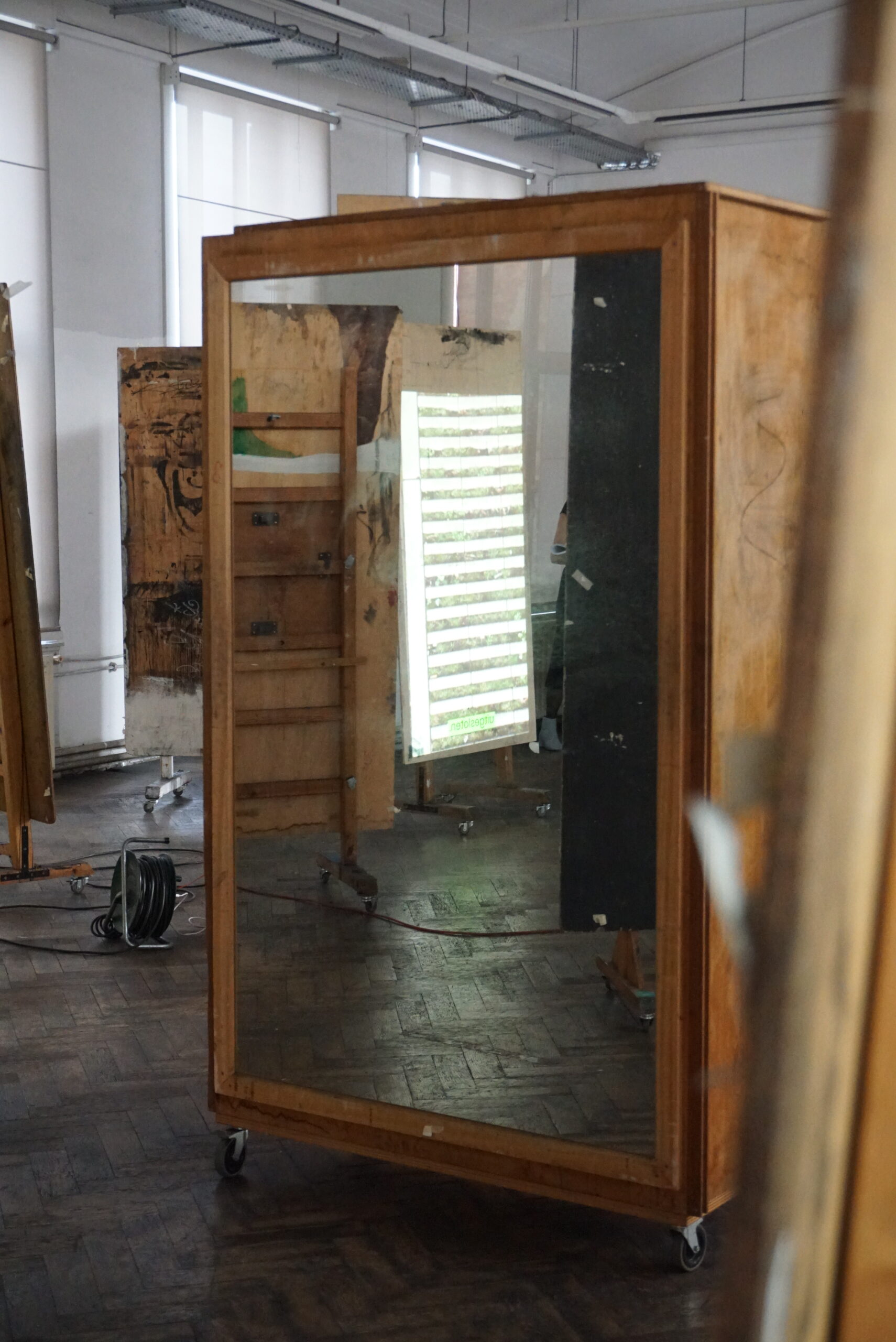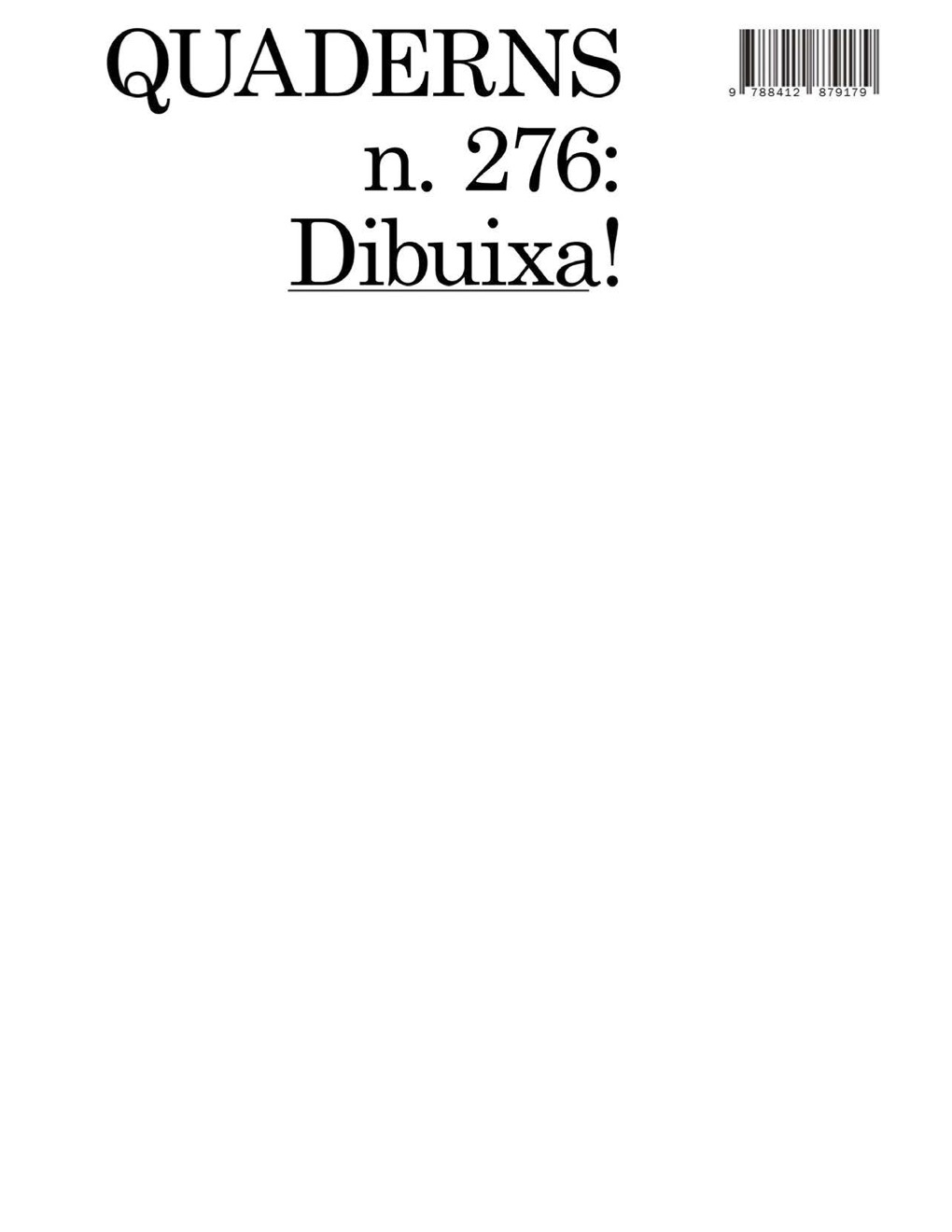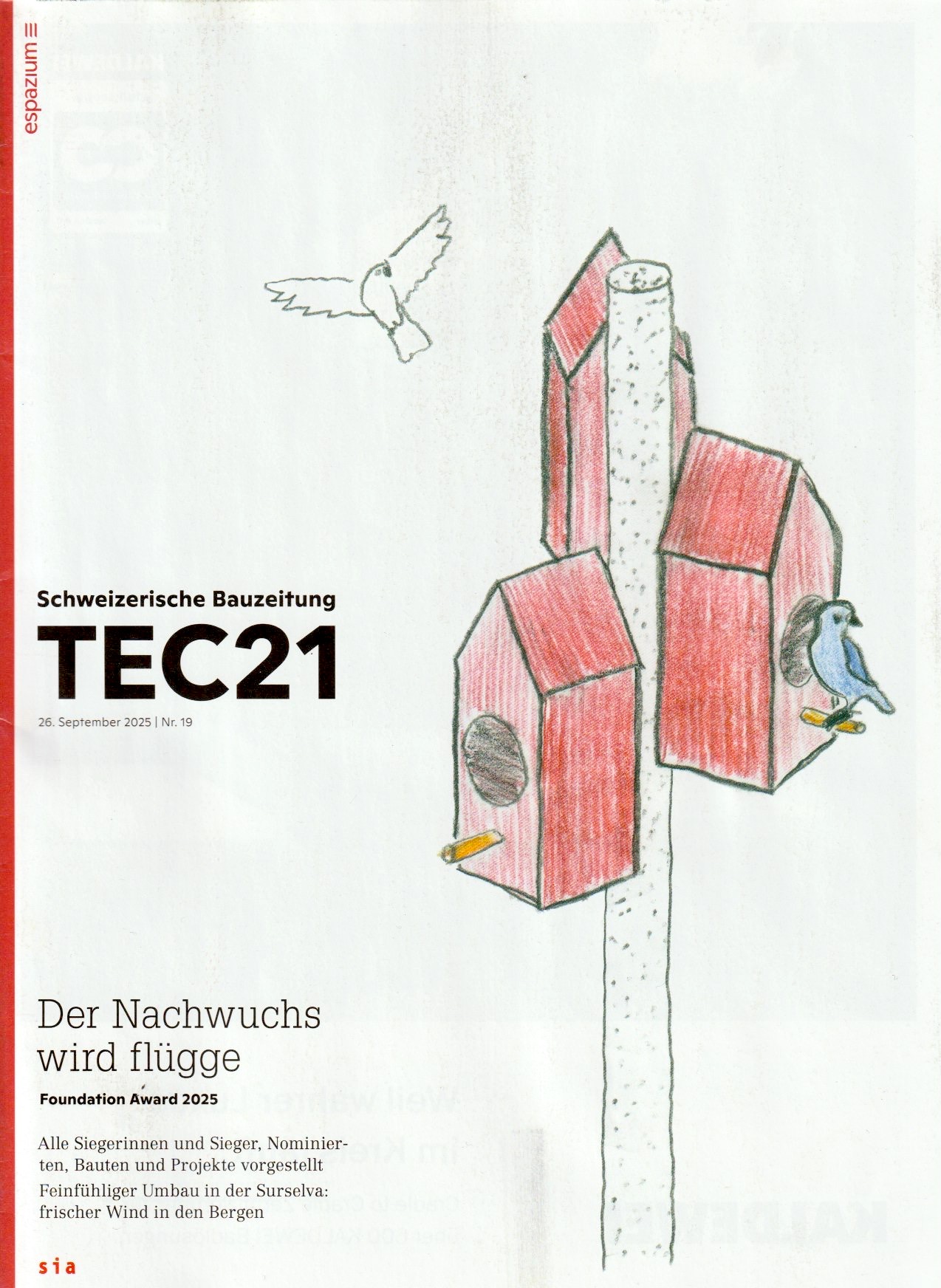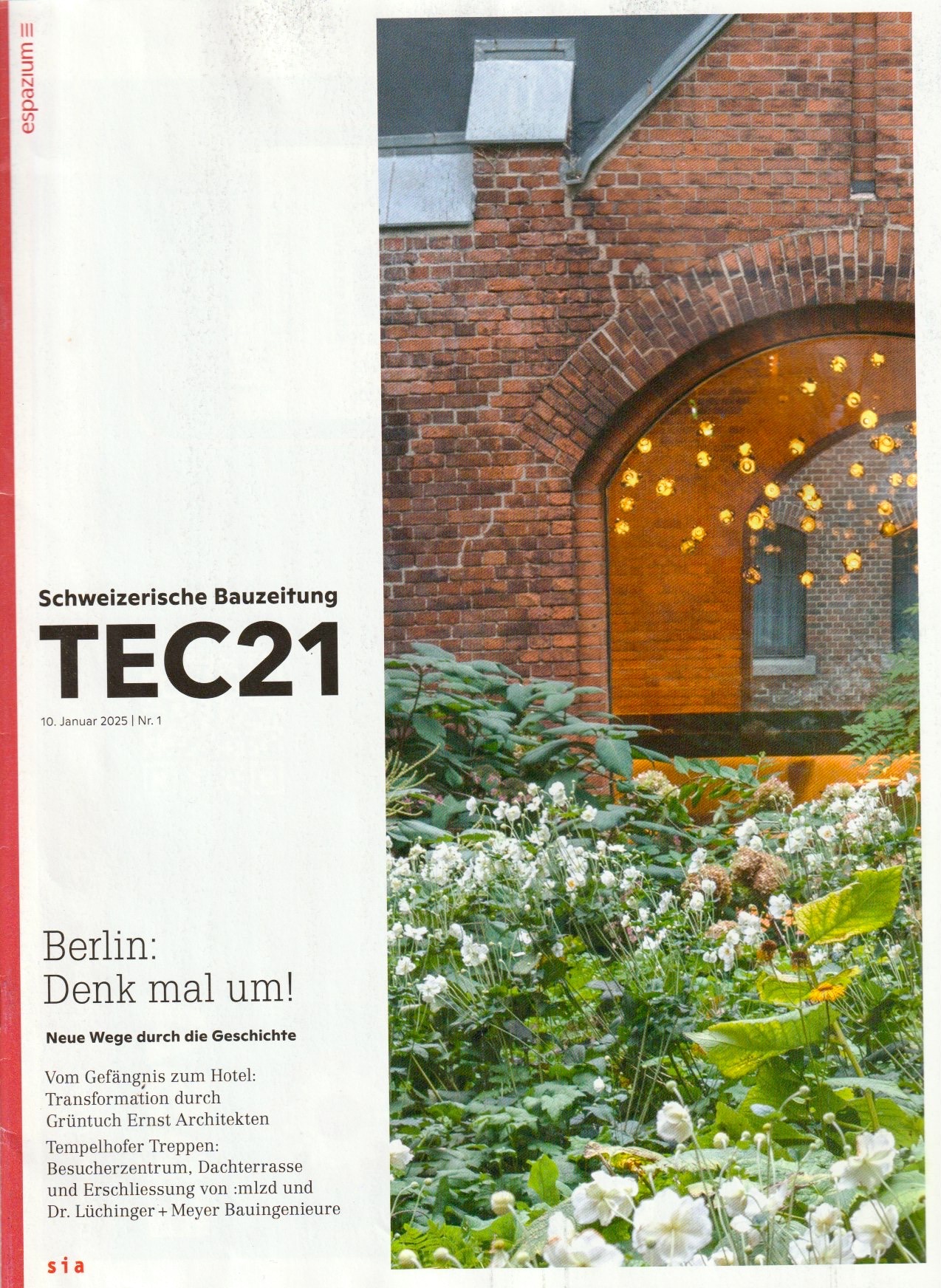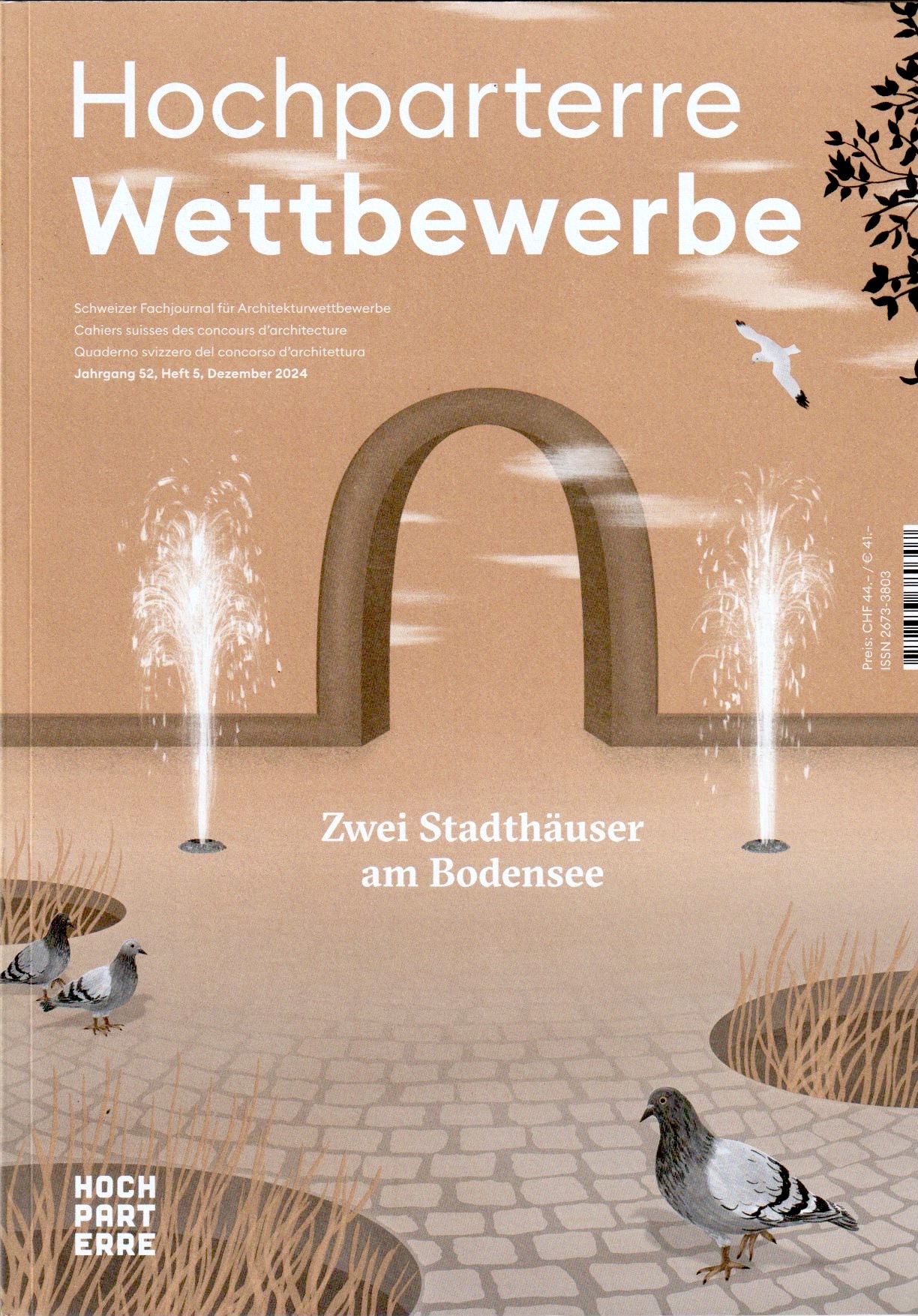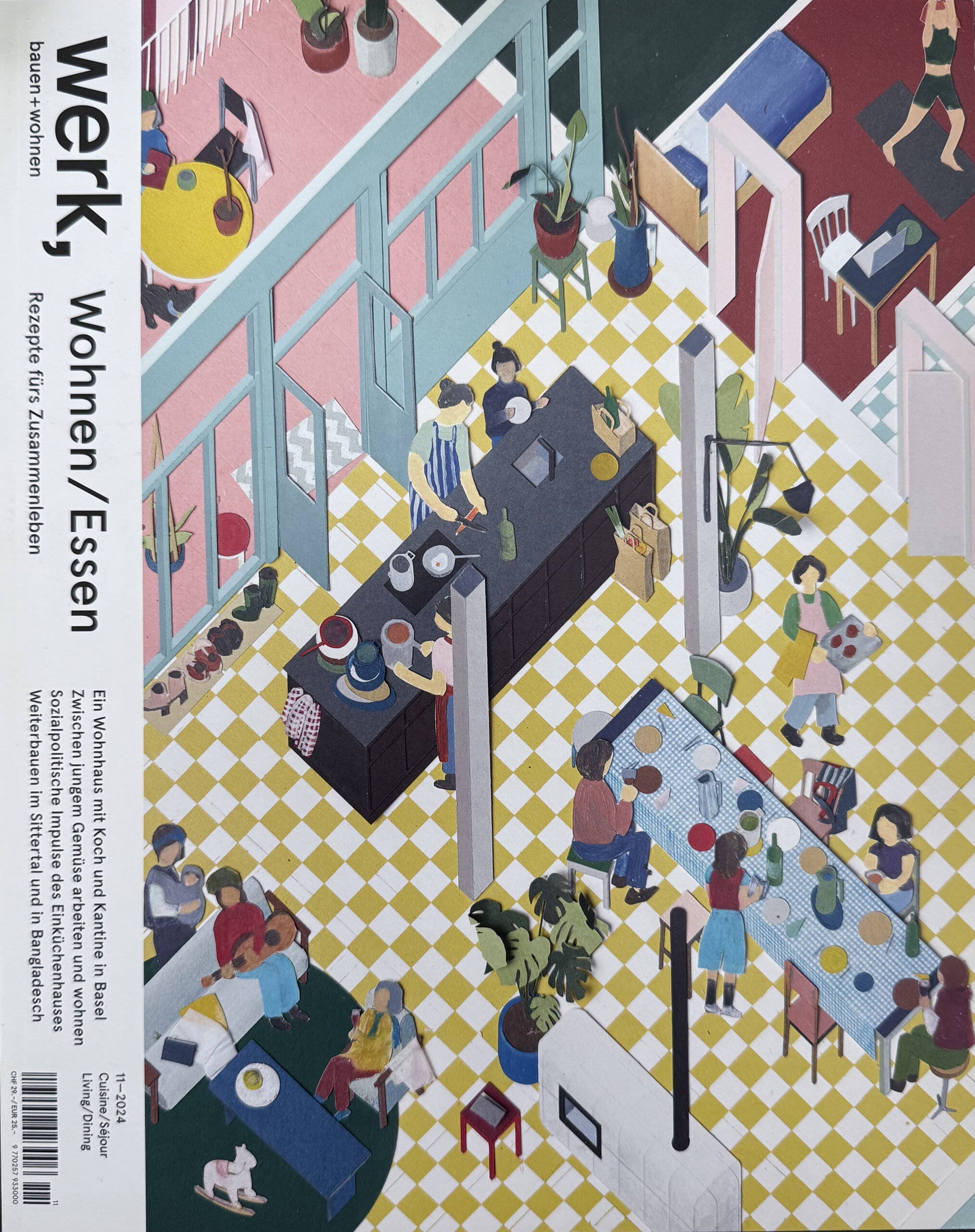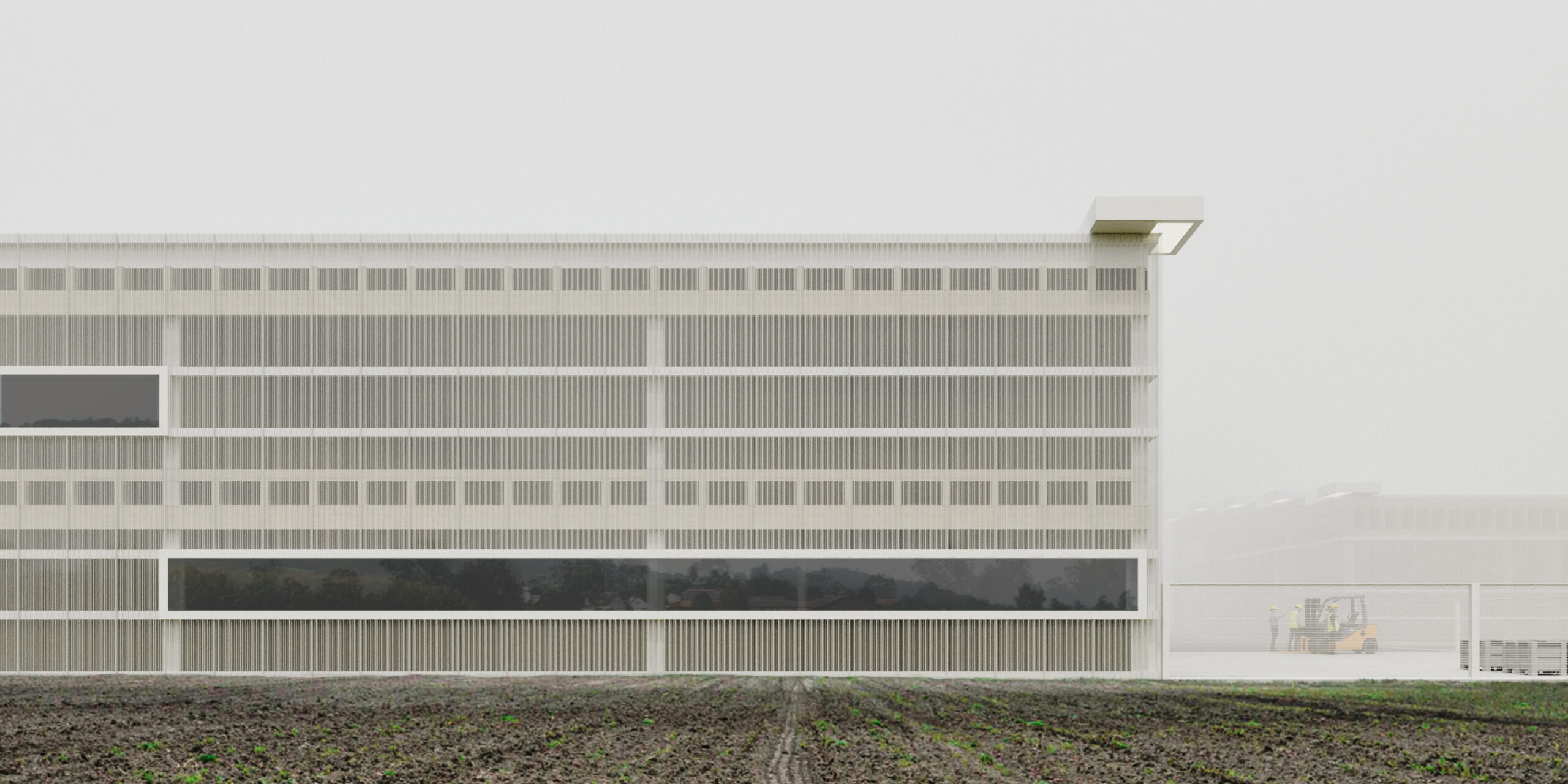After graduating from the Accademia di Architettura di Mendrisio and gaining professional experience in the offices of Jan Kinsbergen and Pascal Flammer, João Lourenço dos Santos and Marija Urbaitė founded URBAITE studio in Zurich. Through their research and professional practice, they explore the tensions and contradictions inherent in the field of architecture. Their current focus is on creating adaptable buildings where space and structure are intricately intertwined, designing educational and office projects in neighbourhoods that lack a distinct identity
Assembled gym hall in St. Gallen. 2025. Restricted competition. Team: Lorenzo Autieri, João Lourenço dos Santos, Roberto Leggeri, Margareta Milenkovic, Andrea Panzeri, Marija Urbaitė and Felix Waldner. Structure: Dr. Ing. Mario Monotti. Building Technology, building physics and Sustainability: Amstein Walthert AG. Renderings: Olivier Campagne. A building that economises not just resources, but gestures. The new sports and community hall in Häggenschwil is conceived as a dry, compact volume — fully above ground, fully timber-framed, and fully legible. It reflects the ambition of thinking space not through added technology, but through reduction and reuse. A strict structural grid organises program, circulation, and load-bearing logic in one gesture. Laminated timber trusses, steel tensioning, and mechanical connections allow for efficient spans, clean assembly, future reversibility and, most importantly, spatial identity.
Cascading apartments in Ticino. 2025. Restricted competition – 2nd prize. Team: Lorenzo Autieri, João Lourenço dos Santos, Roberto Leggeri, Andrea Panzeri and Marija Urbaitė. Structure: co-struct AG. Building Technology, building physics and Sustainability: Tecnoprogetti SA. Landscape: Michel Frey Landschaftsarchitekten GmbH Renderings: Olivier Campagne. This project is a compact residential building conceived for the alpine slope of San Bernardino. Negotiating a steep site between meadow, village, and late-modern fabric, the project translates the idea of living on a slope into a precise architectural system: articulated in four staggered bars, structured in wood, and accessed through a sequence of private loggia. Each apartment occupies its own platform. The typologies are compact yet spatially layered: dual-aspect living spaces, deeply framed balconies, and minimized stair core circulation. The repetition of parts enables both prefabrication and variation — a strategy that reduces waste while preserving individuality. The building is almost entirely timber, with exposed CLT slabs and a structural system optimised for disassembly and reuse. A differentiated structural grain — timber above, concrete below — supports modularity and minimizes material overlap. Services are concentrated, accessible, and upgradeable, allowing for long-term adaptability. The envelope is designed for high alpine performance: mineral-based insulation, ventilated metal cladding, and integrated solar shading. Heating is provided by a pellet system using local biomass, and photovoltaic panels contribute to the building’s operational autonomy. More than a formal gesture, the stepping is a method: to frame views, to calibrate scale — and to propose a new model for rural densification that is both restrained and generous.
Decagon school in Zurich. 2025. Open competition. Team: João Lourenço dos Santos, Kacper Karpinski, Margareta Milenkovic, Marija Urbaitė and Milena Binder. Landscape architecture: studio erde. Structure: Dr. Ing. Neven Kostic. Building Technology: Amstein Walthert AG. Acoustics, building physics, Sustainability: Raumanzug GmbH. In the outskirts of Zürich, where cultivated fields meet institutional fabric, a new figure appears in the landscape. Neither rectilinear nor iconic, this school proposes a quiet revolution in school architecture: a decagon—ten equal sides—resisting hierarchy, suggesting openness, and inviting a different way of inhabiting space. Rather than extend the logic of the existing, Decagon begins with a question: how can form shape relationships? Compact yet porous, the building carves generous outdoor spaces while maintaining a minimal footprint. Each façade is just wide enough to be intimate, just angled enough to shift perspectives. What emerges is not a front or a back, but a spatial field—orientable in every direction, engaged with its surroundings. Inside, the logic continues. There are no traditional corridors. Movement becomes encounter, and circulation turns into collective space. Clusters of classrooms are arranged with precision, yet what defines the experience is the in-between: the fluid zones where learning spills over, where informal gathering becomes part of the pedagogical landscape. The building does not prescribe how to learn—it makes space for learning to unfold. On the top floor, a sports hall floats above the classrooms, its structure expressed and celebrated. Here, the building culminates in openness—physical, spatial, and symbolic. From this height, one sees the landscape again, now re-framed by a school that insists on the possibility of dialogue—between architecture and territory, between permanence and change. Decagon’s sustainability lies not only in its material strategies or technical efficiencies—though these are rigorous and embedded throughout. It lies, more profoundly, in its spatial intelligence: in its refusal of excess, in its embrace of flexibility, and in its belief that architecture can create durable frameworks for the unpredictable rhythms of education and community. This is a school as a civic structure. Modest in footprint, bold in intent, and quietly radical in form—it offers not a template, but a possibility.
Compact school in Zurich. 2025. Open competition. Team: João Lourenço dos Santos and Marija Urbaitė. Landscape architecture: Zeno Zanderigo. Structure: dsp Ingenieure + Planer. Building Technology: Amstein Walthert AG. Acoustics, building physics, Sustainability: Raumanzug GmbH. Renderings: Olivier Campagne. Reference image credits: Outdoor school, Suresnes, 1935, Le Musée d‘histoire Urbaine et Sociale de Suresnes, Paris. This school is conceived as a dynamic and adaptable learning environment, where spatial flexibility supports evolving educational needs. The project balances compactness with openness, creating a structure that is both efficient and inviting. At its core is a clear spatial organization that fosters fluid movement, interaction, and adaptability. The school is structured around a compact ring that accommodates classrooms, enclosing a central volume that houses the auditorium, sports halls, and music rooms. This interplay between the outer ring and the inner core generates diverse spatial situations, enabling different modes of learning, collaboration, and social engagement. Generous circulation spaces, including wide staircases and multi-level connections, encourage spontaneous encounters while ensuring efficient navigation throughout the building. The building’s form—a four-sided polygon—reinforces its identity as a public institution while maintaining a balanced relationship with its environment. Its integration into the landscape minimizes land use, preserves sightlines, and enhances biodiversity, ensuring a thoughtful coexistence with its surroundings. By rethinking the traditional school typology, the this school establishes a precedent for resilient and future-oriented educational infrastructure. Its spatial and structural flexibility allows it to evolve alongside pedagogical and technological advancements, ensuring its long-term relevance as a place for learning, collaboration, and community engagement.
Climate tower for the Brunnenhof school extension in Zurich. 2024-2030. Open competition – 1st prize. Team: João Lourenço dos Santos and Marija Urbaitė. Landscape architecture: Michel Frey Landschaftsarchitekten GmbH. Timber structure: PIRMIN JUNG Schweiz AG. Structure: dsp Ingenieure + Planer AG. Building Technology: Amstein Walthert AG. Acoustics, building physics, Sustainability: Raumanzug GmbH. Renderings: Olivier Campagne. Reference image credits: Outdoor school, Suresnes, 1935, Le Musée d‘histoire Urbaine et Sociale de Suresnes, Paris. The Zurich Brunnenhof School, housed in the former Swiss Radio Studio, will be extended under strict guidelines to meet the Net Zero goal. The new construction, entirely made of timber, is arranged as a stack of volumes without a basement. It includes two classroom clusters, multi-purpose rooms, two sports halls, and a rooftop outdoor sports area. The compact, 30-meter-high tower forms an urban ensemble with the surroundings, particularly complementing the heritage-protected 1970s building by Max Bill. This design creates a new address on Hofwiesenstrasse, where an expressive core with vertical accesses defines an additional school entrance. The design extends the limited area available for outdoor activities by incorporating thematic gardens around and up the new tower. The building’s regulation-driven bold appearance is balanced with an adaptive, performative facade, which is to be planned to incorporate the city’s rapidly changing and cataloged resources for reuse
Future workshops in car-parking for Innovationspark Zurich. 2023. Restricted competition. Team: Maksim Cuturilo, João Lourenço dos Santos, Lukasz Palczynski and Marija Urbaitė. Structure: Dr. Ing. Mario Monotti. Building Technology: Amstein Walthert AG. Renderings: AIVA Images. Reference image credits: Marco Cappelletti / Filip Dujardin. This project is conceived as an infrastructure distinct from conventional parking facilities, designed as an adaptable structure that anticipates the evolving demands of transportation, urban space, education, and work environments. By integrating flexibility at every level, the project ensures that its function can evolve over time, transforming from a parking facility into a space for work, research, and social interaction. The non-destructive disassembly and reassembly of building components have been prioritized, reinforcing a commitment to adaptability and sustainability. By embracing modularity, reversibility, and spatial efficiency, this project challenges the traditional notion of infrastructure as static. Instead, it envisions a built environment in constant flux, ready to adapt to emerging mobility trends and urban needs
Low-tech office building in St. Gallen. 2022-25. Direct commission. Team: João Lourenço dos Santos, Marija Urbaitė and Pascal Waldburger. Structure: Seger Ingenieure. Building Technology: HHM. Building Physics BB&A
Extension of an apartment building. 2020-21. Direct comission. Team: João Lourenço dos Santos and Marija Urbaitė. Structure: Aschwanden & Partner. Timber Engineer Renggli. Building Physics gae. Building Technology 3-Plan Haustechnik. Timber Construction Kost Holzbau. Photography: Oliver Cretton. The residential building from the 50s has been raised to create two 3.5 room apartments within the maximum volume allowed by the building code. The cross laminated timber floor elements span the width of the structure to transfer the loads into the exterior walls of the existing building. In order to reduce the construction time to the minimum, the wooden building elements were entirely prefabricated and were assembled within four days. All wiring has been planned in 3D and inserted into milled recesses in wooden components
Modular school in Chablais. 2021. Open competition – 4th prize. Team: João Lourenço dos Santos, David Klemmer, Jan Kinsbergen and Marija Urbaitė. Structure: Dr. Ing. Neven Kostic. Landscape: Proap – Estudos E Projectos De Arquitectura Paisagista. Renderings: Studio Diode. The construction principles define the volumes and shape the character of the interior, as the building method with serial prefabricated elements remains visible, without cladding. The proposed modular concept consists of columns, panels and diagonal elements. The composite panels of 2.38m x 7.14m are placed on four wooden columns to form tables that are lined up or stacked to form the space. A truss construction of wooden diagonals stabilizes the whole and allows large spans to be bridged
Flexible university building ETH HIC. 2019. Selected competition. Team: João Lourenço dos Santos, Jan Kinsbergen and Marija Urbaitė. Structure: Dr. Ing. Mario Monotti. Building Technology: Amstein Walthert AG. Climate consultant: Transolar. Renderings: Studio Diode. In response to a competition brief emphasizing innovation and flexibility, we explored the concept of spatial adaptability in three dimensions. This led to the development of a lightweight construction system—reducing material weight by approximately 40%—that creates a transformative and provisional space. Rather than imposing a fixed environment, the project invites students to engage with the space on their own terms, improvising within a flexible framework. Our process-based approach rejects definitive beginnings and endings, instead embracing continuous transformation—an architecture conceived as loops rather than final products. This perspective shifts the focus from static design outcomes to the ongoing dynamics of construction, use, and adaptation. Loops are endless. We are drawn to the visual language of construction sites, both for their raw spatial qualities and for the way they blur the boundaries between building, renovation, and disassembly. These images amplify the informal and provisional nature of architecture, highlighting its inherent mutability. We believe that the monumental quality of modern architecture is not found in permanence, but in its making—the process of transformation, adaptation, and appropriation that defines space itself
Academic since 2025 Lecturer. ETH Zürich – Studio Foundations / 2022-2025 Research Associate. USI Accademia di Architettura di Mendrisio – Chair of Dr. Prof. Mario Monotti / 2025 Lecture. ETH Zürich Chair Bautechnologie und Konstruktion Dozentur Mettler Studer / 2025 Lecture. School of Architecture, Southeast University, FROM IDEA TO SPACE: The Thought and Practice of Emerging European Architects’ – Public Lecture series Spring 2025 / 2024 Tutorship. University of Antwerp. International Design Week / 2023 Guest critic. University of Genova. Atelier Philipp Wündrich / 2022 Guest critic. University IUAV. Laboratorio Michel Carlana / 2022-2023 Research Associate. Technical University of Munich. Chair of Prof. Jeanette Kuo / 2002 Lecture. USI Accademia di Architettura di Mendrisio. Chair of Dr. Prof. Mario Monotti
Publications TEC21 19/2025 – Berlin: Denk mal um! / Quaderns d’arquitectura i urbanisme Nr 276 (2025): Dibuixa! – ‘Una lista de dibujos aparentemente hechos a mano Urtzi Grau’, Guillermo Fernández-Abascal p. 111-123 / Hochpartherre Wettbewerbe Jahrgang 52, Heft 5, 2024 – Zwei Stadthäuser am Bodensee / Werk, Bauen + Wohnen 11–2024 – Beim Schulhaus-Wettbewerb Brunnenhof in Zürich schlagen STUDIO URBAITE vor, die Turnhalle nicht einzugraben, undgewinnen. Um den Boden zu schonen, stapeln sie dieNutzungen vor dem einstigen Radiostudio, in dem zukünftigebenfalls Schulraum unterkommt. Ducken vor dem Max-Bill-Bau kam nicht in Frage. Volker Bienert / Hochparterre – Flucht in die Höhe. Olga Rausch / Plates – Edited by Claudia Mion, images by David Klemmer. texts and drawings by Jan Kinsbergen and Neven Kostic. Graphic design by Spassky Fischer. Published by Caryatide. September 2024. English edition. 24 x 34 cm Brochure. 184 pages. ISBN : 978-2-493283-21-4 / TEC21 19/2025 – Der Nachwuchs wrid flügge / Dixit #4 – Edited by Simon Campedel. Editorial coordination: Juliette Pochard. Project: ETH HIC. Construction: Jan Kinsbergen, URBAITE, Mario Monotti. Image: David Klemmer. Graphic design: Spassky Fischer with Lucas Lejeune. Published by Caryatide. July 2022. Bilingual edition (English and French) 23 x 30 cm (softcover) 64 pages (ill.) ISBN: 9782493283108. / Always work in progress – Caryatide. La galerie d’Architecture Paris. 2021 / The Architect’s Atlas – Series Mendrisio Academy Press. Edited by Bruno Pedretti. 2015. Binding Paperback. Size 17 x 24 cm. Pages 252. Illustrations 160 color, 120 in b/w. Language Italian and English. 2016. ISBN 9788836634569. / Atelier Bearth, Microcosmi – edited by Mihail Amariei. 2012. 20 x 24 cm, 352 pp. 500 ill. col. and b/w hardcover. English and Italian. ISBN 9788887624564
Exhibitions/Installations Physical Digital. University of Antwerp. 2024. Photography: Felix Waldner. The pervasive feeling of malaise and existential emptiness, which is central to the theme of alienation, serves as a symptomatic manifestation of contemporary life. This phenomenon consistently surfaces when examining issues like labor conditions within capitalist societies, leisure and consumption, disconnection from nature, and the all-encompassing impact of technology on our daily existence. Today, we are witnessing the exacerbation of this troubling condition due to our increasing and paradoxical isolation within hyper-connected societies. The migration of public spaces to the digital realm has transformed us into profitable data streams and faceless commentators. Considering our inherently social nature, face-to-face communication has always been a cornerstone of human interaction. However, what are the repercussions for our societies when physical presence is anathematized? / Always work in progress. Organisation Caryatide. La galerie d’Architecture Paris. 2021. / Feÿ Arts Festival. Villecien, Burgundy. 2019. Installation in collaboration with Myriam Treiber, Sergio Torres, Emanuelle Agustoni
Contacts Kanzleistrasse 115 – 8004 Zürich / +41 43 437 53 90 / info@urbaite.ch / CHE-146.342.368 MWST
Privacy policy We make every effort to ensure that the information provided is as accurate and up-to-date as possible. The contents have been carefully compiled. Nevertheless errors can occur. URBAITE GmbH accepts no responsibility or liability for the accuracy, reliability, completeness and timeliness of the information on this and/or linked websites. Anonymous data collection and processing Unless otherwise stated in the following sections, no personal data will be collected, processed or used when using our website. However, we learn certain technical information about the use of the webaccess log and from Google Analytics on the basis of the data transmitted by your browser (e.g. browser type/version, operating system used, websites visited on our site incl. duration of visit, previously visited website). We only evaluate this information for statistical purposes. It is periodically deleted. Google Analytics This website uses Google Analytics, a web analysis service of Google Inc, (1600 Amphitheatre Parkway Mountain View, CA 94043, USA; “Google”). Use includes the “Universal Analytics” mode of operation. This makes it possible to assign data, sessions and interactions across several devices to a pseudonymous user ID and thus to analyze the activities of a user across all devices. Google Analytics uses “cookies”, which are text files placed on your computer, to help the website analyze how users use the site. The information generated by the cookie about your use of the website will generally be transmitted to and stored by Google on servers in the United States. You may refuse the use of cookies by selecting the appropriate settings on your browser, however please note that if you do this you may not be able to use the full functionality of this website. Cookies We also use so-called cookies for the purpose of improving our web offers. Cookies are text information files that your web browser stores on your computer when you open one of our websites. We use this cookie technology to tailor our websites to your preferences. If you want to prevent the use of cookies, you can refuse the acceptance of cookies in your browser. Please refer to the instructions of your browser manufacturer to find out how this works in detail. We collect personal data when you voluntarily provide us with it, for example when you contact us. The personal data transmitted to us in this way will only be used for direct communication with you. A communication of this information takes place expressly on a voluntary basis and with your consent. Insofar as this information relates to communication channels (e.g. e-mail address, telephone number), you also agree that we may also contact you via this communication channel. Security We have taken extensive technical and operational precautions to protect your data from accidental or intentional manipulation, loss, destruction or access by unauthorized persons. Our security procedures are regularly reviewed and adapted to technological progress. No data transmission to third parties Your data will not be passed on to third parties unless we are legally obliged to do so. Insofar as external service providers come into contact with your personal data, we have taken legal, technical and organisational measures and carried out regular checks to ensure that they comply with the provisions of data protection legislation. Right to information We will be pleased to inform you whether and which of your personal data is stored by us and delete it if desired. Data Protection Officer Our data protection officer will be happy to assist you with these matters: info@urbaite.ch General disclaimer of liability All information on our website has been carefully checked. We make every effort to ensure that the material contained in its web site is current, complete and correct. Nevertheless, the occurrence of errors cannot be completely excluded, so that we cannot guarantee the completeness, accuracy and timeliness of information, including journalistic editorial nature. Liability claims arising from material or immaterial damage caused by the use of the information provided are excluded, unless there is evidence of wilful intent or gross negligence. The publisher may change or delete texts at his own discretion and without prior notice and is not obliged to update the contents of this website. The use of or access to this website is at the visitor’s own risk. The publisher, its clients or partners are not responsible for damages, such as direct, indirect, accidental, pre-determined or consequential damages, which are allegedly caused by visiting this website and therefore assume no liability. The publisher also assumes no responsibility and liability for the content and availability of third-party websites that can be accessed via external links on this website. The operators of the linked sites are solely responsible for their content. The publisher hereby expressly dissociates himself from all contents of third parties which may be relevant under criminal or liability law or which violate common decency. Links to other websites Our website contains links to various websites which are not covered by this privacy statement. Insofar as the collection, processing or use of personal data is associated with the use of the Internet pages of other providers, please observe the data protection information there. Changes to the data protection declaration We reserve the right to change this privacy statement at any time in accordance with applicable data protection laws Imprint Concept and graphic design by URBAITE / Coding by Bureau Castel / All rights reserved. No part of this website may be reproduced, stored in a retrieval system, or by any means, electronic, mechanical, or otherwise without permission in writing from the publisher ©2025






